Table of Contents
- Introduction
- Smart PDU Front Panel
- Command Line Interface
- Web Interface
- Device Management
- Environment
- Logs
- Administration: Security
- Administration: Network Features
- Administration: Notification
- Administration: General Options
- Device IP Configuration Wizard
- How to Export Configuration Settings
- File Transfers
- Troubleshooting
- Appendix A: List of Supported Commands
APC SPD10KCBL User Manual
Displayed below is the user manual for SPD10KCBL by APC which is a product in the Power Distribution Units (PDUs) category. This manual has pages.
Related Manuals

User Guide
Metered Smart Power
Distribution Unit
SPD5K
SPD5KCB
SPD5KCBL
SPD10K
SPD10KCB
SPD10KCBL
SPD20K
SPD20KCB
SPD20KCBL


Contents
Metered Smart PDU User Guide i
Introduction..................................................................... 1
Product Features. . . . . . . . . . . . . . . . . . . . . . . . . . . . . . . . . . . . . . . . . .1
Access Priorities for Logging on. . . . . . . . . . . . . . . . . . . . . . . . . . . . .2
Types of User Accounts. . . . . . . . . . . . . . . . . . . . . . . . . . . . . . . . . . . .2
Watchdog Features. . . . . . . . . . . . . . . . . . . . . . . . . . . . . . . . . . . . . . . .3
Overview . . . . . . . . . . . . . . . . . . . . . . . . . . . . . . . . . . . . . . . . . . . . . . . 3
Network interface watchdog mechanism . . . . . . . . . . . . . . . . . . . . . 3
Resetting the network timer . . . . . . . . . . . . . . . . . . . . . . . . . . . . . . . 3
Getting Started . . . . . . . . . . . . . . . . . . . . . . . . . . . . . . . . . . . . . . . . . . .3
Establish Network Settings . . . . . . . . . . . . . . . . . . . . . . . . . . . . . . . . .4
TCP/IP configuration methods . . . . . . . . . . . . . . . . . . . . . . . . . . . . . 4
INI file utility . . . . . . . . . . . . . . . . . . . . . . . . . . . . . . . . . . . . . . . . . . . . 4
DHCP and BOOTP configuration . . . . . . . . . . . . . . . . . . . . . . . . . . . . 4
Command Line Interface . . . . . . . . . . . . . . . . . . . . . . . . . . . . . . . . . . 6
Recovering from a Lost Password . . . . . . . . . . . . . . . . . . . . . . . . . . .7
Smart PDU Front Panel .................................................. 8
Display Tree Example 1 . . . . . . . . . . . . . . . . . . . . . . . . . . . . . . . . . . 11
Display Tree Example 2 . . . . . . . . . . . . . . . . . . . . . . . . . . . . . . . . . . 12
Network Status LED . . . . . . . . . . . . . . . . . . . . . . . . . . . . . . . . . . . . . 13
10/100 LED . . . . . . . . . . . . . . . . . . . . . . . . . . . . . . . . . . . . . . . . . . . . . 13
Load indicator LED . . . . . . . . . . . . . . . . . . . . . . . . . . . . . . . . . . . . . . 13
Bypass indicator LED . . . . . . . . . . . . . . . . . . . . . . . . . . . . . . . . . . . . 14
Modbus . . . . . . . . . . . . . . . . . . . . . . . . . . . . . . . . . . . . . . . . . . . . . . . 14
Command Line Interface.............................................. 15
About the Command Line Interface . . . . . . . . . . . . . . . . . . . . . . . . .15
Log on to the Command Line Interface . . . . . . . . . . . . . . . . . . . . . .15
Remote access to the command line interface . . . . . . . . . . . . . . . 15
Local access to the command line inte rface . . . . . . . . . . . . . . . . . 16
About the Main Screen. . . . . . . . . . . . . . . . . . . . . . . . . . . . . . . . . . . .16
Using the Command Line Interface. . . . . . . . . . . . . . . . . . . . . . . . . .17
Command Syntax . . . . . . . . . . . . . . . . . . . . . . . . . . . . . . . . . . . . . . . .18

Metered Smart PDU User Guideii
Command Response Codes . . . . . . . . . . . . . . . . . . . . . . . . . . . . . . . 19
Network Management Card Command Descriptions . . . . . . . . . . . 20
about . . . . . . . . . . . . . . . . . . . . . . . . . . . . . . . . . . . . . . . . . . . . . . . . . . 20
alarmcount . . . . . . . . . . . . . . . . . . . . . . . . . . . . . . . . . . . . . . . . . . . . . 20
boot . . . . . . . . . . . . . . . . . . . . . . . . . . . . . . . . . . . . . . . . . . . . . . . . . . . 21
cd . . . . . . . . . . . . . . . . . . . . . . . . . . . . . . . . . . . . . . . . . . . . . . . . . . . . 21
clrrst . . . . . . . . . . . . . . . . . . . . . . . . . . . . . . . . . . . . . . . . . . . . . . . . . . 21
console . . . . . . . . . . . . . . . . . . . . . . . . . . . . . . . . . . . . . . . . . . . . . . . . 22
date . . . . . . . . . . . . . . . . . . . . . . . . . . . . . . . . . . . . . . . . . . . . . . . . . . . 23
delete . . . . . . . . . . . . . . . . . . . . . . . . . . . . . . . . . . . . . . . . . . . . . . . . . 23
dir . . . . . . . . . . . . . . . . . . . . . . . . . . . . . . . . . . . . . . . . . . . . . . . . . . . . 23
dns . . . . . . . . . . . . . . . . . . . . . . . . . . . . . . . . . . . . . . . . . . . . . . . . . . . 24
eventlog . . . . . . . . . . . . . . . . . . . . . . . . . . . . . . . . . . . . . . . . . . . . . . . 24
exit . . . . . . . . . . . . . . . . . . . . . . . . . . . . . . . . . . . . . . . . . . . . . . . . . . . 24
format . . . . . . . . . . . . . . . . . . . . . . . . . . . . . . . . . . . . . . . . . . . . . . . . . 24
FTP . . . . . . . . . . . . . . . . . . . . . . . . . . . . . . . . . . . . . . . . . . . . . . . . . . . 25
help . . . . . . . . . . . . . . . . . . . . . . . . . . . . . . . . . . . . . . . . . . . . . . . . . . . 25
netstat . . . . . . . . . . . . . . . . . . . . . . . . . . . . . . . . . . . . . . . . . . . . . . . . . 25
ntp . . . . . . . . . . . . . . . . . . . . . . . . . . . . . . . . . . . . . . . . . . . . . . . . . . . . 25
ping . . . . . . . . . . . . . . . . . . . . . . . . . . . . . . . . . . . . . . . . . . . . . . . . . . . 26
portSpeed . . . . . . . . . . . . . . . . . . . . . . . . . . . . . . . . . . . . . . . . . . . . . . 26
prompt . . . . . . . . . . . . . . . . . . . . . . . . . . . . . . . . . . . . . . . . . . . . . . . . 26
quit . . . . . . . . . . . . . . . . . . . . . . . . . . . . . . . . . . . . . . . . . . . . . . . . . . . 26
radius . . . . . . . . . . . . . . . . . . . . . . . . . . . . . . . . . . . . . . . . . . . . . . . . . 27
reboot . . . . . . . . . . . . . . . . . . . . . . . . . . . . . . . . . . . . . . . . . . . . . . . . . 27
resetToDef . . . . . . . . . . . . . . . . . . . . . . . . . . . . . . . . . . . . . . . . . . . . . 28
snmp, snmpv3 . . . . . . . . . . . . . . . . . . . . . . . . . . . . . . . . . . . . . . . . . . 28
system . . . . . . . . . . . . . . . . . . . . . . . . . . . . . . . . . . . . . . . . . . . . . . . . 28
tcpip . . . . . . . . . . . . . . . . . . . . . . . . . . . . . . . . . . . . . . . . . . . . . . . . . . 29
tcpip6 . . . . . . . . . . . . . . . . . . . . . . . . . . . . . . . . . . . . . . . . . . . . . . . . . 29
user . . . . . . . . . . . . . . . . . . . . . . . . . . . . . . . . . . . . . . . . . . . . . . . . . . . 30
web . . . . . . . . . . . . . . . . . . . . . . . . . . . . . . . . . . . . . . . . . . . . . . . . . . . 30
xferINI . . . . . . . . . . . . . . . . . . . . . . . . . . . . . . . . . . . . . . . . . . . . . . . . . 31
xferStatus . . . . . . . . . . . . . . . . . . . . . . . . . . . . . . . . . . . . . . . . . . . . . . 31

Metered Smart PDU User Guide iii
Device Command Descriptions . . . . . . . . . . . . . . . . . . . . . . . . . . . . .32
Network Port Sharing Commands . . . . . . . . . . . . . . . . . . . . . . . . . . 32
bkLowLoad . . . . . . . . . . . . . . . . . . . . . . . . . . . . . . . . . . . . . . . . . . . . . 32
bkNearOver . . . . . . . . . . . . . . . . . . . . . . . . . . . . . . . . . . . . . . . . . . . . . 32
bkOverLoad . . . . . . . . . . . . . . . . . . . . . . . . . . . . . . . . . . . . . . . . . . . .33
bkReading . . . . . . . . . . . . . . . . . . . . . . . . . . . . . . . . . . . . . . . . . . . . . . 33
devLowLoad . . . . . . . . . . . . . . . . . . . . . . . . . . . . . . . . . . . . . . . . . . . . 33
devNearOver . . . . . . . . . . . . . . . . . . . . . . . . . . . . . . . . . . . . . . . . . . . . 34
devOverLoad . . . . . . . . . . . . . . . . . . . . . . . . . . . . . . . . . . . . . . . . . . . 34
devReading . . . . . . . . . . . . . . . . . . . . . . . . . . . . . . . . . . . . . . . . . . . . . 34
humLow . . . . . . . . . . . . . . . . . . . . . . . . . . . . . . . . . . . . . . . . . . . . . . . 35
humMin . . . . . . . . . . . . . . . . . . . . . . . . . . . . . . . . . . . . . . . . . . . . . . . . 35
humReading . . . . . . . . . . . . . . . . . . . . . . . . . . . . . . . . . . . . . . . . . . . .35
phLowLoad . . . . . . . . . . . . . . . . . . . . . . . . . . . . . . . . . . . . . . . . . . . . . 36
phNearOver . . . . . . . . . . . . . . . . . . . . . . . . . . . . . . . . . . . . . . . . . . . . 36
phOverLoad . . . . . . . . . . . . . . . . . . . . . . . . . . . . . . . . . . . . . . . . . . . . 36
phReading . . . . . . . . . . . . . . . . . . . . . . . . . . . . . . . . . . . . . . . . . . . . .37
prodInfo . . . . . . . . . . . . . . . . . . . . . . . . . . . . . . . . . . . . . . . . . . . . . . . 38
sensorName . . . . . . . . . . . . . . . . . . . . . . . . . . . . . . . . . . . . . . . . . . . .38
tempHigh . . . . . . . . . . . . . . . . . . . . . . . . . . . . . . . . . . . . . . . . . . . . . . 39
tempMax . . . . . . . . . . . . . . . . . . . . . . . . . . . . . . . . . . . . . . . . . . . . . . . 39
tempReading . . . . . . . . . . . . . . . . . . . . . . . . . . . . . . . . . . . . . . . . . . . 39
whoami . . . . . . . . . . . . . . . . . . . . . . . . . . . . . . . . . . . . . . . . . . . . . . . . 40
Web Interface.................................................................41
Supported Web Browsers. . . . . . . . . . . . . . . . . . . . . . . . . . . . . . . . . .41
Logging On to the Web Interface. . . . . . . . . . . . . . . . . . . . . . . . . . . .41
Overview . . . . . . . . . . . . . . . . . . . . . . . . . . . . . . . . . . . . . . . . . . . . . . .41
URL address formats . . . . . . . . . . . . . . . . . . . . . . . . . . . . . . . . . . . . .42
Web Interface Features. . . . . . . . . . . . . . . . . . . . . . . . . . . . . . . . . . . .43
Tabs . . . . . . . . . . . . . . . . . . . . . . . . . . . . . . . . . . . . . . . . . . . . . . . . . . . 43
Device status icons . . . . . . . . . . . . . . . . . . . . . . . . . . . . . . . . . . . . . . 43
Quick Links . . . . . . . . . . . . . . . . . . . . . . . . . . . . . . . . . . . . . . . . . . . . . 44
Other Web interface features . . . . . . . . . . . . . . . . . . . . . . . . . . . . . . 44
About the Home Tab . . . . . . . . . . . . . . . . . . . . . . . . . . . . . . . . . . . . . .45
The Overview view . . . . . . . . . . . . . . . . . . . . . . . . . . . . . . . . . . . . . . .45
The Alarm Status view . . . . . . . . . . . . . . . . . . . . . . . . . . . . . . . . . . . . 4 5
Device Management......................................................46
About the Device Manager Tab . . . . . . . . . . . . . . . . . . . . . . . . . . . . .46
Viewing the Load Status and Peak Load. . . . . . . . . . . . . . . . . . . . . .46

Metered Smart PDU User Guideiv
Configuring Load Thresholds . . . . . . . . . . . . . . . . . . . . . . . . . . . . . . 46
Configure the Name and Location of the Smart PDU . . . . . . . . . . . 47
Resetting Peak Load and kWh . . . . . . . . . . . . . . . . . . . . . . . . . . . . . 47
Environment...................................................................48
Configure Temperature and Humidity Sensors. . . . . . . . . . . . . . . . 48
Logs................................................................................49
Use the Event and Data Logs . . . . . . . . . . . . . . . . . . . . . . . . . . . . . . 49
Event log . . . . . . . . . . . . . . . . . . . . . . . . . . . . . . . . . . . . . . . . . . . . . . 49
Data log . . . . . . . . . . . . . . . . . . . . . . . . . . . . . . . . . . . . . . . . . . . . . . . 51
How to use FTP or SCP to retrieve log files . . . . . . . . . . . . . . . . . . 53
Administration: Security...............................................54
Local Users . . . . . . . . . . . . . . . . . . . . . . . . . . . . . . . . . . . . . . . . . . . . . 54
Setting user access . . . . . . . . . . . . . . . . . . . . . . . . . . . . . . . . . . . . . . 54
Remote Users . . . . . . . . . . . . . . . . . . . . . . . . . . . . . . . . . . . . . . . . . . . 54
Authentication . . . . . . . . . . . . . . . . . . . . . . . . . . . . . . . . . . . . . . . . . . 54
RADIUS . . . . . . . . . . . . . . . . . . . . . . . . . . . . . . . . . . . . . . . . . . . . . . . . 55
Configure the RADIUS Server . . . . . . . . . . . . . . . . . . . . . . . . . . . . . . 56
Summary of the configuration procedure . . . . . . . . . . . . . . . . . . . . 56
Configuring a RADIUS server on UNIX® with shadow passwords 56
Supported RADIUS servers . . . . . . . . . . . . . . . . . . . . . . . . . . . . . . . 56
RADIUS and Network Port Sharing . . . . . . . . . . . . . . . . . . . . . . . . . 56
Inactivity Timeout . . . . . . . . . . . . . . . . . . . . . . . . . . . . . . . . . . . . . . . 57
Administration: Network Features...............................58
TCP/IP and Communication Settings . . . . . . . . . . . . . . . . . . . . . . . . 58
TCP/IP settings . . . . . . . . . . . . . . . . . . . . . . . . . . . . . . . . . . . . . . . . . 58
DHCP response options . . . . . . . . . . . . . . . . . . . . . . . . . . . . . . . . . . 59
Port Speed. . . . . . . . . . . . . . . . . . . . . . . . . . . . . . . . . . . . . . . . . . . . . . 60
Ping Response . . . . . . . . . . . . . . . . . . . . . . . . . . . . . . . . . . . . . . . . . . 60
DNS . . . . . . . . . . . . . . . . . . . . . . . . . . . . . . . . . . . . . . . . . . . . . . . . . . . 61
Web . . . . . . . . . . . . . . . . . . . . . . . . . . . . . . . . . . . . . . . . . . . . . . . . . . . 62
Console . . . . . . . . . . . . . . . . . . . . . . . . . . . . . . . . . . . . . . . . . . . . . . . . 63

Metered Smart PDU User Guide v
SNMP . . . . . . . . . . . . . . . . . . . . . . . . . . . . . . . . . . . . . . . . . . . . . . . . . .64
SNMPv1 . . . . . . . . . . . . . . . . . . . . . . . . . . . . . . . . . . . . . . . . . . . . . . . .65
SNMPv3 . . . . . . . . . . . . . . . . . . . . . . . . . . . . . . . . . . . . . . . . . . . . . . . .66
FTP Server . . . . . . . . . . . . . . . . . . . . . . . . . . . . . . . . . . . . . . . . . . . . . .68
Administration: Notification .........................................69
Event Actions. . . . . . . . . . . . . . . . . . . . . . . . . . . . . . . . . . . . . . . . . . . .69
Types of notification . . . . . . . . . . . . . . . . . . . . . . . . . . . . . . . . . . . . . 69
Configuring event actions . . . . . . . . . . . . . . . . . . . . . . . . . . . . . . . . . 69
Active, Automatic, Direct Notification . . . . . . . . . . . . . . . . . . . . . . . .71
E-mail notification . . . . . . . . . . . . . . . . . . . . . . . . . . . . . . . . . . . . . . . 71
SNMP traps . . . . . . . . . . . . . . . . . . . . . . . . . . . . . . . . . . . . . . . . . . . . . 73
SNMP Trap Test . . . . . . . . . . . . . . . . . . . . . . . . . . . . . . . . . . . . . . . . . 73
Remote Monitoring Service . . . . . . . . . . . . . . . . . . . . . . . . . . . . . . . 74
Syslog . . . . . . . . . . . . . . . . . . . . . . . . . . . . . . . . . . . . . . . . . . . . . . . . . 74
Administration: General Options.................................76
Identification . . . . . . . . . . . . . . . . . . . . . . . . . . . . . . . . . . . . . . . . . . . .76
Set the Date and Time. . . . . . . . . . . . . . . . . . . . . . . . . . . . . . . . . . . . .76
Mode . . . . . . . . . . . . . . . . . . . . . . . . . . . . . . . . . . . . . . . . . . . . . . . . . .76
Daylight saving . . . . . . . . . . . . . . . . . . . . . . . . . . . . . . . . . . . . . . . . . 77
Format . . . . . . . . . . . . . . . . . . . . . . . . . . . . . . . . . . . . . . . . . . . . . . . . . 77
Use an .ini File . . . . . . . . . . . . . . . . . . . . . . . . . . . . . . . . . . . . . . . . . . .77
Event Log and Temperature Units. . . . . . . . . . . . . . . . . . . . . . . . . . .78
Color-code event log text . . . . . . . . . . . . . . . . . . . . . . . . . . . . . . . . . 78
Change the default temperature scale . . . . . . . . . . . . . . . . . . . . . . . 78
Reset the Smart PDU. . . . . . . . . . . . . . . . . . . . . . . . . . . . . . . . . . . . . .78
Configure Links. . . . . . . . . . . . . . . . . . . . . . . . . . . . . . . . . . . . . . . . . .79
About the Smart PDU . . . . . . . . . . . . . . . . . . . . . . . . . . . . . . . . . . . . .79
Device IP Configuration Wizard ...................................80
Capabilities, Requirements, and Installation . . . . . . . . . . . . . . . . . .80
How to use the Wizard to configure TCP/IP settings . . . . . . . . . . . 80
System requirements . . . . . . . . . . . . . . . . . . . . . . . . . . . . . . . . . . . . 80
Installation . . . . . . . . . . . . . . . . . . . . . . . . . . . . . . . . . . . . . . . . . . . . . 8 0

Metered Smart PDU User Guidevi
Use the Wizard . . . . . . . . . . . . . . . . . . . . . . . . . . . . . . . . . . . . . . . . . . 80
Launch the Wizard . . . . . . . . . . . . . . . . . . . . . . . . . . . . . . . . . . . . . . . 80
Configure the basic TCP/IP settings remotely . . . . . . . . . . . . . . . . 80
Configure or reconfigure the TCP/IP settings locally . . . . . . . . . . 81
How to Export Configuration Settings ........................82
Retrieving and Exporting the .ini File. . . . . . . . . . . . . . . . . . . . . . . . 82
Summary of the procedure . . . . . . . . . . . . . . . . . . . . . . . . . . . . . . . . 82
Contents of the .ini file . . . . . . . . . . . . . . . . . . . . . . . . . . . . . . . . . . . 82
Detailed procedures . . . . . . . . . . . . . . . . . . . . . . . . . . . . . . . . . . . . . 83
The Upload Event and Error Messages . . . . . . . . . . . . . . . . . . . . . . 85
The event and its error messages . . . . . . . . . . . . . . . . . . . . . . . . . . 85
Messages in config.ini . . . . . . . . . . . . . . . . . . . . . . . . . . . . . . . . . . . 85
Errors generated by overridde n values . . . . . . . . . . . . . . . . . . . . . . 85
Related Topics . . . . . . . . . . . . . . . . . . . . . . . . . . . . . . . . . . . . . . . . . . 85
File Transfers.................................................................86
How to Upgrade Firmware. . . . . . . . . . . . . . . . . . . . . . . . . . . . . . . . . 86
Benefits of upgrading firmware . . . . . . . . . . . . . . . . . . . . . . . . . . . . 86
Firmware module files (Smart PDU) . . . . . . . . . . . . . . . . . . . . . . . . . 86
Firmware File Transfer Methods . . . . . . . . . . . . . . . . . . . . . . . . . . . . 86
Using the Firmware Upgrade Utility . . . . . . . . . . . . . . . . . . . . . . . . . 87
Use FTP or SCP to upgrade one Smart PDU . . . . . . . . . . . . . . . . . . 87
Use XMODEM to upgrade one Smart PDU . . . . . . . . . . . . . . . . . . . 88
How to upgrade multiple Smart PDUs . . . . . . . . . . . . . . . . . . . . . . . 89
Using the Firmware Upgrade Utility for multiple upgrades . . . . . . 89
Verifying Upgrades and Updates . . . . . . . . . . . . . . . . . . . . . . . . . . . 90
Verify the success or failure of the transfer . . . . . . . . . . . . . . . . . . 90
Last Transfer Result codes . . . . . . . . . . . . . . . . . . . . . . . . . . . . . . . 90
Verify the version numbers of installed firmware. . . . . . . . . . . . . . 90
Troubleshooting............................................................91
Smart PDU Access Problems . . . . . . . . . . . . . . . . . . . . . . . . . . . . . . 91
For problems that pe rsist or are not described here, see the back cover of this
manual. . . . . . . . . . . . . . . . . . . . . . . . . . . . . . . . . . . . . . . . . . . . . . . . . 91
Appendix A: List of Supported Commands................92
Network Management Card Command Descriptions . . . . . . . . . . . 92
Device Command Descriptions . . . . . . . . . . . . . . . . . . . . . . . . . . . . 94

Metered Smart PDU User Guide1
Introduction
Product Features
The Schneider Electric Metered Smart Power Distribution Unit (PDU) may be used as a stand-alone,
network-manageable power distribution device or up to 4 devices can be connected together with one
network connection. The Smart PDU provides real-time remote monitoring of connected loads. User-
defined alarms warn of potential circuit overloads.
Your unit comes with one terminator installed. It is not needed for stand-alone operation of this unit. To
use Network Port Sharing between up to four units, a terminator must be installed in the In port at one
end of the group and another on the Out port at the other end of the group.
You can manage a Smart PDU through its Web interface, its command line interface (CLI),
Strux ureWare, Modbus, or Simple Network Management Protocol (SNMP). (To use the PowerNet MIB
with an SNMP browser, see the PowerNet SNMP Management Information Base (MIB) Reference
Guide, available at www.apc.com.) Smart PDUs have these additional features:
• Peak load, and power and energy monitoring for all connected loads.
• Voltage, current, and power monitoring for phases.
• Current monitoring for ou tlet banks.
• Configurable alarm thresholds that provide network and visual alarms to help avoid overloaded
circuits.
• Three levels of user access accounts: Administrator, Device User, and Read-Only User.
• Event and data logging. The event log is accessible by Telnet, Secure CoPy (SCP), File Transfer
Protocol (FTP), serial connection, or Web browser (using HTTPS access with SSL, or using
HTTP access). The data log is accessible by Web browser, SCP, or FTP.
• E-mail notifications for Smart PDU and system events.
• SNMP traps, Syslog messages, and e-mail notifications based on the severity level or category of
the Smart PDU and system events.
• Security protocols for authentication and encryption.
• Supports Modbus RTU over serial RS485 port.
• Supports Modbus over TCP.
Note: The Smart PDU does not provide power surge protection. To ensure that the device is protected
from power failure or power surges, connect the Smart PDU to an APC Uninterruptible Power Supply
(UPS).

2Metered Rack PDU User Guide
Access Priorities for Logging on
Only one user at a time can log on to the Smart PDU. The priority for access, beginning with the highest
priority, is as follows:
• Local access to the command line interface from a computer with a direct serial connection to the
Smart PDU
• Telnet or Secure SHell (SSH) access to the command line interface from a remote computer
• Web access, either directly or through StruxureWare Data Center Expert
Note: See “SNMP” on page 64 for information about how SNMP access to the Smart PDU is
controlled.
Types of User Accounts
The Smart PDU has three levels of access (Administrator, Device User , and Read-Only User), which are
protected by user name and password requirements.
• An Administrator can use all of the menus in the Web interface and all of the commands in the
command line interface. The default user name and password are both apc.
• A Device User can access only the following:
– In the Web interface, the menus on the Device Manager tab, th e Environment tab, and the
event and data logs, accessible under the Events and Data headings on the left navigation
menu of the Logs tab. The event and data logs display no button to clear the log.
– In the command line interface , the equivalent features and options.
The default user name is device, and the default password is apc.
• A Read-Only User has the following restricted access:
– Access through the Web interface only.
– Access to the same tabs and menus as a Device User, but without the capability to change
configurations, control devices, delete data, or use file transfer options. Links to configuration
options are visible but disabled. The event and data logs display no button to clear the log.
The default user name is readonly, and the default password is apc. To set User Name and
Password values for the three account types above, see “Setting user access” on page 54.

Metered Smart PDU User Guide3
Watchdog Features
Overview
To detect internal problems and recover from unantic ipated inputs, the Smart PDU uses internal, system-
wide watchdog mechanisms. When it restarts to recover from an internal problem, a System:
Warmstart event is recorded in the event log.
Network interface watchdog mechanism
The Smart PDU implements internal watchdog mechanisms to protect itself from becoming inaccessible
over the network. For example, if the Smart PDU does not receive any network traffic for 9.5 minutes
(either direct traffic, such as SNMP, or broadcast traffic, such as an Address Resolution Protocol [ARP]
request), it assumes that there is a problem with its network interface and restarts.
Resetting the network timer
To ensure that the Smart PDU does not restart if the network is quiet for 9.5 minutes, the Smart PDU
attempts to contact the default gateway every 4.5 minutes. If the gateway is present, it responds to the
Smart PDU, and the response restarts the 9.5-minute timer . If your appli cation does not requir e or have a
gateway, specify the IP address of a computer that is running on the network and is on the subnet. The
network traffic of that computer will restart the 9.5-minute time frequently enough to prevent the Smart
PDU from restarting.
Getting Started
To start using the Smart PDU:
1. Install the Smart PDU using the Smart Power Distribution Unit Installation Instructions that
were shipped with your Smart PDU.
2. Apply power and connect to your network . Follow the directions in the Smart Power Distribution
Unit Installation Instructions.
3. Establish network settings. (See “Establish Network Settings” on page 4.)
4. Begin using the Smart PDU by way of one of the following:
– “Web Interface” on page 41
– “Command Line Interface” on page 15
– “Smart PDU Front Panel” on page 8

4Metered Rack PDU User Guide
Establish Network Settings
Note: Disregard the procedures described in this section if you have StruxureWare Data Center Expert
as part of your system. See the documentation for your StruxureWare Data Center Expert device for
more information.
You must configure the following TCP/IP settings before the Smart PDU can operate on a network:
• IP address of the Smart PDU
• Subnet mask
• Default gateway
Note: If a default gateway is unavailable, use the IP address of a computer that is located on the
same subnet as the Smart PDU and that is usually running. The Smart PDU uses the default
gateway to test the network when traffic is very light.
Note: Do not use the loopback address (127.0.0.1) as the default gateway address for the Smart
PDU. It disables the card and requires you to reset TCP/IP settings to their defaults using a local
serial login.
See “Watchdog Features” on page 3 for more information about the watchdog role of the default
gateway.
TCP/IP configuration methods
Use one of the following methods to define the TCP/IP settings needed by the Smart PDU:
• “Device IP Configuration Wizard” on page 80
• “DHCP and BOOTP configuration” on page 4
• “Command Line Interface” on page 6
INI file utility
You can use the INI file export utility to export INI file settings from configured Smart PDUs to one or
more unconfigured Smart PDUs. For more information, see “Use an .ini File” on page 77.
DHCP and BOOTP configuration
The default TCP/IP configuration setting, DHCP, assumes that a properly configured DHCP server is
available to provide TCP/IP settings to Smart PDU. You can also configure the setting for BOOTP.
A user configuration (INI) file can function as a BOOTP or DHCP boot file. For more information, see
“Use an .ini File” on page 77.
If neither of these servers is available, see “Device IP Configuration Wizard” on page 80 or “Command
Line Interface” on page 6.
BOOTP. For the Smart PDU to use a BOOTP server to configure its TCP/IP settings, it must find a
properly configured RFC9 51-compliant BOOTP serv er.
In the BOOTPTAB file of the BOOTP server, enter the Smart PDU’s MAC address, IP address, subnet
mask, and default gateway, and, optionally, a b ootup file name. Look for the MAC address on the bottom
of the Smart PDU or on the Quality Assurance slip included in the package.

Metered Smart PDU User Guide5
When the Smart PDU reboots, the BOOTP server provides it with the TCP/IP settings.
• If you specified a bootup file name, the Smart PDU attempts to transfer that file from the BOOTP
server using TFTP or FTP. The Smart PDU assumes all settings specified in the bootup file.
• If you did not specify a bootup file name, you can configure the o ther settings of the Smart PDU
remotely through its “Web Interface” on page 41 or “Command Line Interface” on page 6; the
user name and password are both apc, by default. To create a bootup file, see your BOOTP server
documentation.
DHCP. You can use an RFC2131/RFC2132-compliant DHCP server to configure the TCP/IP settings for
the Smart PDU.
This section summarizes the Smart PDU’s communication with a DHCP server. For more detail about
how a DHCP server can configure the network settings for a Smart PDU, see “DHCP response options”
on page 59.
1. The Smart PDU sends out a DHCP request that uses the following to identify itself:
– A Vendor Class Identifier (APC by default)
– A Client Identifier (by default, the MAC address of the Smart PDU)
– A User Class Identifier (by default, the identification of the application firmware installed on
the Smart PDU)
– A Host Name (by default, apcXXYYZZ with XXYYZZ being the last six digits of the PDU).
This is known as DHCP Option 12.
2. A properly configured DHCP server responds with a DHCP offer that includes all the settings
that the Smart PDU needs for network communication. The DHCP offer also includ es the Vendor
Specific Information option (DHCP option 43). The Smart PDU can be configured to ignore
DHCP offers that do not encapsulate the APC cookie in DHCP optio n 43 using the following
hexadecimal format. (The Smart PDU does not require this cookie by default.)
Option 43 = 01 04 31 41 50 43
Where:
– The first byte (01) is the code.
– The second byte (04) is the length.
– The remaining bytes (31 41 50 43) are the APC cookie.
See your DHCP server documentation to add code to the Vendor Specific Information option.
Note: By selecting the Require vendor specific cookie to accept DHCP Addr ess check box
in the Web interface, you can require the DHCP server to provide an “APC” cookie, which
supplies information to the Smart PDU: Administration > Network>TCP/IP>ipv4 settings.

6Metered Rack PDU User Guide
Command Line Interface
1. Log on to the command line interface. See “Log on to the Command Line Interface” on page 15.
2. Contact your network administrator to obtain the IP address, subnet mask, and default gateway
for the Smart PDU.
3. Use these three commands to configure network settings. (Text in italics indicates a variable.)
a. tcpip -i yourIPaddress
b. tcpip -s yourSubnetMask
c. tcpip -g yourDefaultGateway
For each variable, type a numeric value that has the format xxx.xxx.xxx.xxx.
For example, to set a system IP address of 156.205.14.141 , type the following command
and press ENTER:
tcpip -i 156.205.14.141
4. Type exit. The Smart PDU restarts to apply the changes.

Metered Smart PDU User Guide7
Recovering from a Lost Password
You can use a local computer (a computer that connects to the Smart PDU or other device through the
serial port) to access the command line interface.
1. Select a serial port at the local computer, and disable any service that uses that port.
2. Connect the serial cable (APC part number 940-0144A) to the selected port on the computer and
to the Serial port at the Smart PDU.
3. Run a terminal program (such as HyperTerminal®) and configure the selected port for 9600 bps,
8 data bits, no parity, 1 stop bit, and no flow control.
4. Press ENTER, repeatedly if necessary, to display the User Name prompt. If you are unable to
display the User Name prompt, verify the following:
– The serial port is not in use by another application.
– The terminal settings are correct as specified in step 3.
– The correct cable is being used as specified in step 2.
5. Press the Reset button. The Status LED will flash alternately orange and green. Press the Reset
button a second time immediately while the LED is flashing to reset the user name and password
to their defaults temporarily.
6. Press ENTER, repeatedly if necessary, to display the User Name prompt again, then use the
default, apc, for the user name and password. (If you take longer than 30 seconds to log on after
the User Name prompt is re-displayed, you must repeat step 5 and log on again.)
7. At the command line interface, use the following commands to change the User Name and
Password settings, both of which are now apc:
user -an yourAdministratorName
user -ap yourAdministratorPassword
For example, to change the Administrator user name to Admin, type:
user -an Admin
8. Type quit or exit to log off, reconnect any serial cable you disconnected, and restart any service
you disabled.
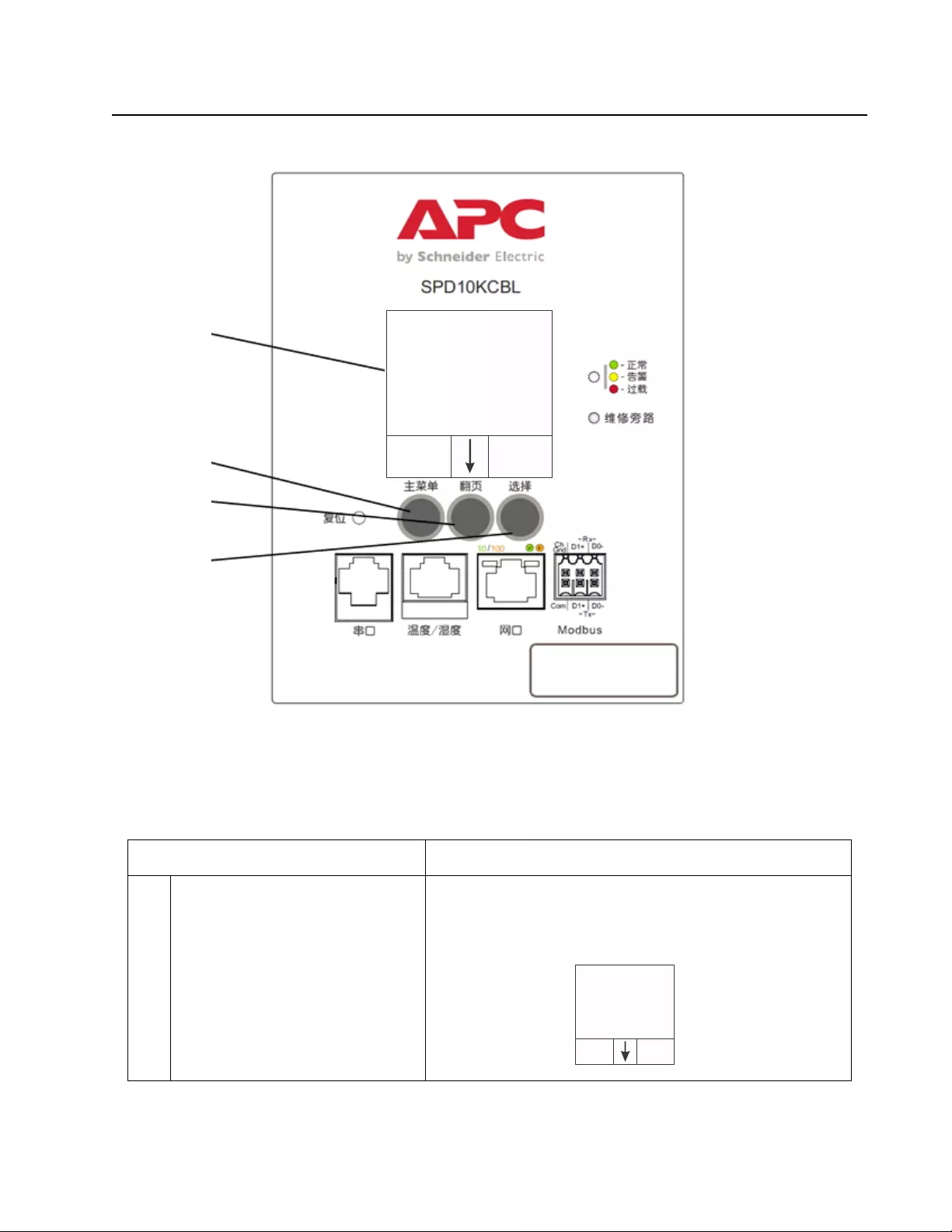
8Metered Rack PDU User Guide
Smart PDU Front Panel
Note: Your APC product is configured so the display backlight turns off after 10 minutes of inactivity.
The backlight can be turned on by depressing any button below the display.
Item Function
Display Shows information about the Smart PDU. In normal operation,
input voltage, current, and power refreshes every five seconds. To
reverse the text, press and hold simultaneously for five seconds
the Main Menu (), Scroll (), and Select () buttons.
SELECTMAIN
Input
229 V
19.1 A
4.37 kW
SELECT
MAIN
Input
229 V
19.1 A
4.37 kW
pdu0511b

Metered Smart PDU User Guide9
Main Menu button Press to view the Smart PDU electrical
input, shown below.
Scroll button Press once to display the menu. Press
additional tim e s to highlight the desired
menu option.
Select button With a menu option highlighted, press the
Select button to display Smart PDU
information. Software Info is shown below.
Item Function
SELECT
MAIN
Input
229 V
19.1 A
4.37 kW
pdu0511b
pdu0512c
SELECT
MAIN
Display Settings
Softw are Info
Network
SKU/Serial #
SELECT
MAIN
IPv4 Add
ress
123.456.7
8.91
pdu0513b
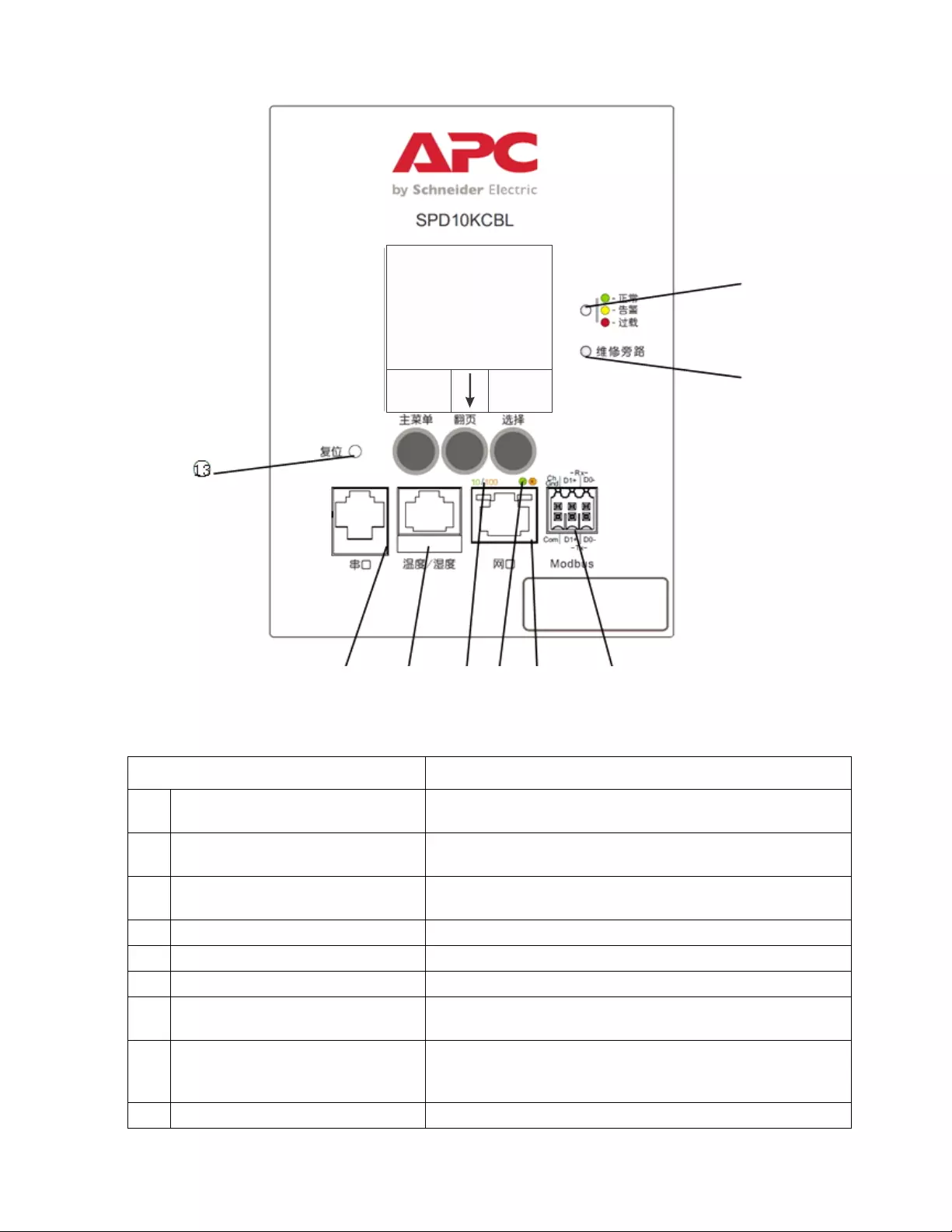
10Metered Rack PDU User Guide
Item Function
OK, Warning, Overload LED Indicates the status of the Smart PDU load. See “Load indicator
LED” on page 13.
Bypass LED Indicates the status of the Smart PDU bypass. See “Bypass
indicator LED” on page 14.
Modbus connector Conn ects the Managem ent Card to a B u ilding Management
System (BMS). See “Modb us” on page 14
10/100 Base-T Connector Connects the Smart PDU to the network.
Network status LED See “Network Status LED” on page 13
10/100 LED See “10/100 LED” on page 13
Temp/Humidity port Port for connecting an APC Temperature Sensor (AP9335T) or an
APC Temperature/Humidity Sensor (AP9335TH).
RJ-12 Serial Port Port for connecting the Smart PDU to a terminal emulator program
for local access to the command line interface. Use the supplied
serial cable (APC part number 940-0144A).
Reset button Resets the Smart PDU without affecting the outlet status.
SELECTMAIN
Input
229 V
19.1 A
4.37 kW
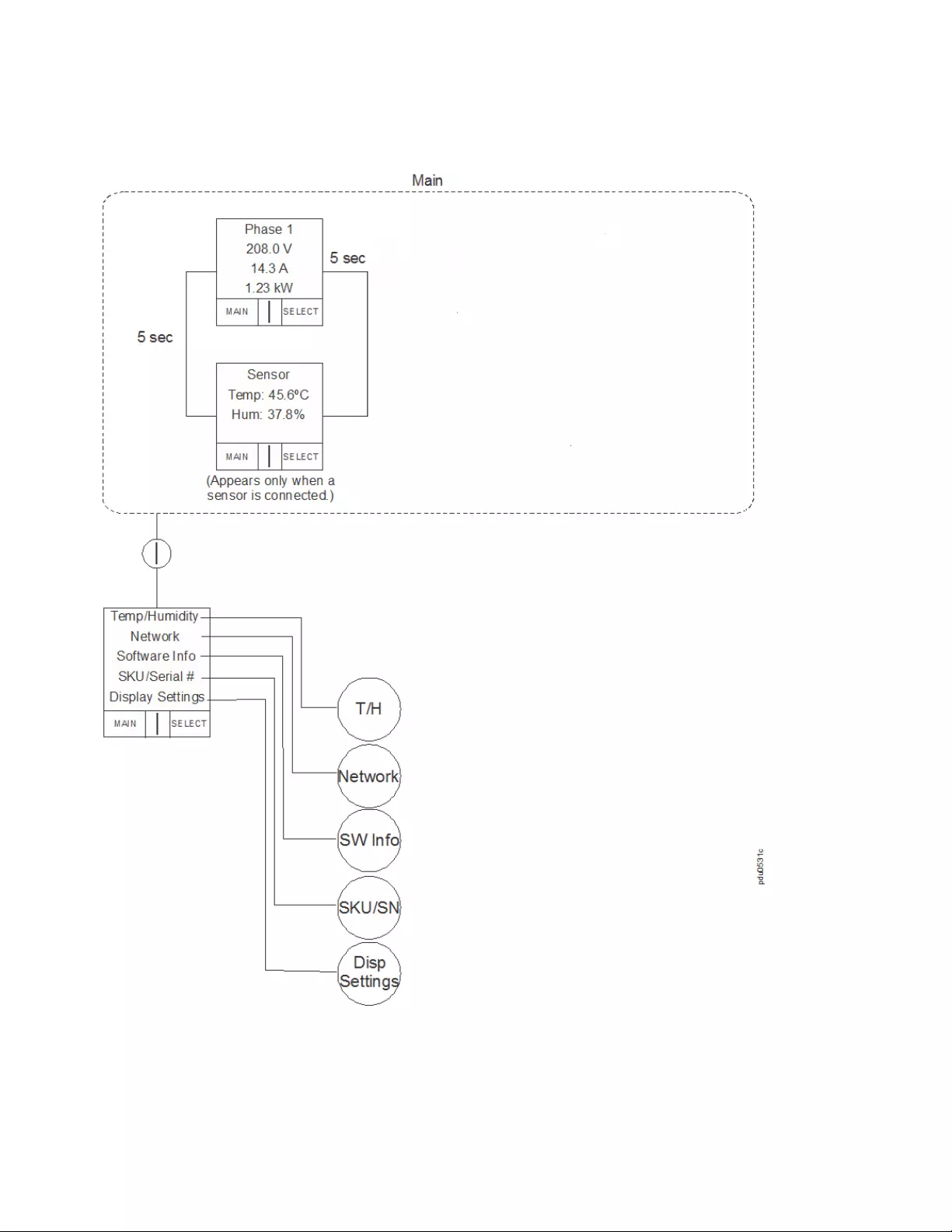
Metered Smart PDU User Guide11
Display Tree Example 1

12Metered Rack PDU User Guide
Display Tree Example 2

Metered Smart PDU User Guide13
Network Status LED
10/100 LED
Load indicator LED
The load indicator LED identifies overload and warning conditions for the Smart PDU.
Condition Description
Off One of the following situations exists:
• The Smart PDU is not receiving input power.
• The Smart PDU is not operating properly. It may need to be repaired or
replaced. Contact APC Customer Support.
Solid Green The Smart PDU has valid TCP/IP settings.
Solid Orange A hardware failure has been detected in the Smart PDU. Contact APC
Customer Support .
Flashing Green The Smart PDU does not have valid TCP/IP settings.
Flashing Orange The Smart PDU is making BOOTP requests.
Alternately flashing green
and orange If the LED is flashing slowly, the Smart PDU is maki ng DHCP2 requests1.
If the LED is flashing ra pidly, the Smart PDU is starting up.
1. If you do not use a BOOTP or DHCP server, see “Establish Network Settings” on page 4 to configure the
TCP/IP settings of the Smart PDU.
2. To use a DHCP server, see “TCP/IP and Communicati on Settin gs” on page 58.
Condition Description
Off One or more of the following situations exists:
• The Smart PDU is not receiving input power.
• The cable that connects the Smart PDU to the network is disconn ect e d or
defective
• The device that connects the Smart PDU to th e network is turned off.
• The Smart PDU itself is not operat ing properly. It may need to be repaired or
replaced. Contact APC Customer Support.
Solid green The Smart PDU is connected to a network operating at 10 Megabits per second
(Mbps).
Solid orange The Smart PDU is connected to a network operatin g at 100 Mbp s.
Flashing green The Smart PDU is receiving or transmitting data packets at 10 Mbps.
Flashing orange The Smart PDU is receiving or transmitting data packets at 100 Mbps.
Condition Description
Solid Green OK. No load alarms (warning or critical) are present.
Solid Yellow Warning. At least one load warning alarm is present, but no critical alarms are
present.
Flashing Red Overload. At least one load critical alarm is present.

14Metered Rack PDU User Guide
Bypass indicator LED
Modbus
Modbus lets you view the smart PDU through your building management services interface. It is read-
only.
The modbus interface supports both 2-wire and 4-wire RS-485, plus ground.
Modbus can be configured through both Command Line Interface and Web Interface.
To access the Modbus register map, go to the APC Web site, www.apc.com, and search for SKU number
(e.g. SPD5K).
Condition Description
Off Not bypass mode
Solid Yellow Bypass mode

Metered Smart PDU User Guide15
Command Line Interface
About the Command Line Interface
You can use the co mmand line inte rface to view the status of and configure and manage the Smart PDU.
In addition, the command line interface enables you to create scripts for automated operation. An
Administrator has full access to the command line interface, a Device user has limited acc ess, and a
Read-Only user is completely restricted. (For additional details, see “Types of User Accounts” on
page 2.)
You can configure all parameters of a Smart PDU (including those for which there are not specific CLI
commands) by using the CLI to transfer an INI file to the Smart PDU. The CLI uses XMODEM to
perform the transfer. However, you cannot read the current INI file through XMODEM.
Log on to the Command Line Interface
To access the command line interface, you can use either a local (serial) connection or a remote (Telnet
or SSH) connection with a computer on the same network as the Smart PDU.
Remote access to the command line interface
You can access the command line interface through T elnet or SSH. Telnet is enabled by default. Enabling
SSH disables Telnet.
To enable or disable these access methods, use the Web interface. On the Administration tab, select
Network on the top menu bar, and then the access option under Console on the left navigation menu.
Telnet for basic access. Telnet provides the basic security of authentication by user name and
password, but not the hi gh-security benefits of encryption.
To use Telnet to access the command line interface:
1. From a computer that has access to network on which the Smart PDU is installed, at a command
prompt, type telnet and the IP address for the Smart PDU (for example, telnet
139.225.6.133, when the Smart PDU uses the default Telnet port of 23), and press ENTER.
If the Smart PDU uses a non-default port number (from 5000 to 32768), you must include a
colon or a space, depending on you r Telnet client, between the IP address (or DNS name) and
the port number. (These are commands for general usage: some clients don’t allow you to
specify the port as an argument and some types of Linux might want extra commands).
2. Enter the user name and password (by default, apc and apc for an Administrator, or device and
apc for a Device User).
If you cannot remember your user name or password, see “Recovering from a Lost Password” on
page 7.
SSH for high-security access. If you use the high security of SSL for the Web interface, use SSH for
access to the command line interface. SSH encrypts user names, passwords, and transmitte d data. The
interface, user accounts, and user access rights are the same whether you access the command line
interface through SSH or Telnet, but to use SSH, you must first configure SSH and have an SSH client
program installed on your computer.

16Metered Rack PDU User Guide
Local access to the command line interface
For local access, use a computer that connects to the Smart PDU through the serial port to access the
command line interface:
1. Select a serial port at the computer and disable any service that uses that port.
2. Connect the serial cable (APC part number 940-0144A) from the selected serial port on the
computer to the Serial port on the Smart PDU.
3. Run a terminal program (e.g., HyperTerminal) and configure the selected port for 9600 bps, 8
data bits, no parity, 1 stop bit, and no flow control.
4. Press ENTER. At the prompts, en ter your user name and password.
About the Main Screen
Following is an example of the main screen, which is displayed when you log on to the command
line interface of a Smart PDU.
• Two fields identify the APC operating system (AOS) and application (APP) firmware versions.
The application firmware name identifies the type of device that connects to the network. In the
example above, the application firmware for the Smart PDU is displayed.
Network Management Card AOS vx.x.x
RPDU 2g vx.x.x
• Three fields identify the system name, contact person, and location of the Smart PDU.
Name : Test Lab
Contact : Don Adams
Location : Building 3
• An Up Time field reports how long the Smart PDU has been running since it was last turned on or
reset.
Up Time : 0 Days, 21 Hours, 21 Minutes
• Two fields identify when you logged in, by date and time.
Date : 10/30/2012
Time : 5:58:30
• The User field identifies whether you logged in through the Administrator or Device Manager
account. (The Read Only User account cannot access the command line interface.)
User : Administrator
American Power Conversion Network Management Card AOS vx.x.x
(c)Copyright 2012 All Rights Reserved SPDU PPPP x.x.x
--------------------------------------------------------------------------
Name : Test Lab Date : 10/30/2012
Contact : Don Adams Time : 5:58:30
Location : Building 3 User : Administrator
Up Time : 0 Days, 21 Hours, 21 Minutes Stat : P+ N4+ N6+ A+
APC>

Metered Smart PDU User Guide17
• A Stat field reports the Smart PDU status.
Stat : P+ N4 N6
Note: If P+ is not displayed, contact APC support staff.
Using the Command Line Interface
At the command line interface, use commands to configure the Smart PDU. To use a command, type the
command and press ENTER. Commands and arguments are valid in lowercase, uppercase, or mixed case.
Options are case-sensitive.
While using the command line interface, you can also do the following:
• Type ? and press ENTER to view a list of available commands, based on your account type.
• To obtain information about the purpose and syntax of a specified command, type the command, a
space, and ? or the word help. For example, to view RADI US configuration options, type:
radius ?
or
radius help
• Press the UP arrow key to view the command that was entered most recently in the session. Use
the UP and DOWN arrow keys to scroll through a list of up to ten previous commands.
• Type at least one letter of a command and press the TAB key to scroll through a list of valid
commands that match the text you typed in the command line.
• Type exit or quit to close the connection to the command line interface.
P+ The APC operating system (AOS) is functioning properl y.
IPv4
only IPv6
only IPv4 and
IPv6* Description
N+ N+ N4+ N6+ The network is functioning properly.
N? N6? N4? N6? A BOOTP request cycle is in progress.
N– N6- N4- N6- The Smart PDU failed to connect to the network.
N! N6! N4! N6! Another device is using the Smart PDU IP address.
* The N4 and N6 values can be different from one another: you could, for example, have
N4- N6+.
A+ The application is functioning properly.
A– The application has a bad checksum.
A? The application is initializing.
A! The application is not compatible with the AOS.

18Metered Rack PDU User Guide
Command Syntax
Example of a command that supports multiple options:
user [-an <admin name>] [-ap <admin password>]
In this example, the user command accepts the option -an, which defines the Administrator user name,
and the option -ap, which defines the Administrator password. To change the Administrator user name
and password to XYZ:
1. Type the user command, one option, and the argument XYZ:
user -ap XYZ
2. After the first command succeeds, type the user command, the second option, and the argument
XYZ:
user -an XYZ
Example of a command that accepts mutually exclusive argument s for an option:
alarmcount -p [all | warning | critical]
In this example, the option -p accepts only three arguments: all, warning, or critical. For example, to
view the number of active critical alarms, type:
alarmcount -p critical
The command will fail if you type an argument that is not specified.
Item Description
- Options are preceded by a hyphen.
< > Definitions of options are enclosed in angle bSmartets. For example:
-dp <device password>
[ ] If a command accepts multiple options or an option accepts mutually exclusive
arguments, the values may be enclosed in bSmartets.
| A vertical line between items enclosed in bSmartets or angle bSmartets indicates that
the items are mutually exclusive. You must use one of the items.

Metered Smart PDU User Guide19
Command Response Codes
The command response codes enable scripted operations to detect error conditions reliably without
having to match error message text:
The CLI reports all command operations with the following format:
E [0-9] [0-9] [0-9] : Error message
Code Message
E000 Success
E001 Successfully Issued
E002 Reboot required for change to
take effect
E100 Command failed
E101 Command not found
E102 Parameter Error
E103 Command Line Error
E104 User Level Denial
E105 Command Prefill
E106 Data Not Available
E107 Serial communication with the
Smart PDU has been lost

20Metered Rack PDU User Guide
Network Management Card Command Descriptions
Access: Administrator, Device User
Description: View a list of all the CLI commands available to your account type. To view help text for
a specific command, type the command followed by a question mark.
Example: To view a list of options that are accepted by the alarmcount command, type:
alarmcount ?
about
Access: Administrator, Device User
Description: View hardware and firmware information. This information is useful in troubleshooting
and enables you to determine if updated firmware is available at the APC Web site.
alarmcount
Access: Administrator, Device User
Description:
Example: To view all active warning alarm s, type :
alarmcount -p warning
Option Arguments Description
-p all View the number of active alarms reported by the Smart PDU. Information
about the alarms is provided in the event log.
warning View the number of active warning alarms.
critical View the number of active critical alarms.

Metered Smart PDU User Guide21
boot
Access: Administrator only
Description: Define how the Smart PDU will obtain its network settings, including the IP address,
subnet mask, and default gateway. Then configure the BOOTP or DHCP server settings.
Example: To use a DHCP server to obtain network settings:
1. Type boot -b dhcp
2. Enable the requirement that the DHCP server provide the APC cookie:
boot -c enable
cd
Access: Administrator, Device User
Description: Navigate to a folder in the directory structure of the Smart PDU.
Example 1: To change to the ssh folder and confirm that an SSH security certificate was uploaded to
the Smart PDU:
1. Type cd ssh and press ENTER.
2. Type dir and press ENTER to list the files stored in the SSH folder.
Example 2: To return to the main directory folder, type:
cd ..
clrrst
Access: Administrator, Device User
Description: Clear reset reason.
Option Argument Description
-b
<boot
mode>
dhcp | bootp |
manual Define how the TCP/IP settings will be configured when the Smart PDU
turns on, resets, or restarts. See “TCP/IP and Communication Settings” on
page 58 for information about each boot mode setting.
-c enable | disable dhcp and dhcpBootp boot modes only. Enable or disable the requirement
that the DHCP server provide the APC cookie.
The default values for these three settings generally do not need to be changed:
-v <vendor class>: APC
-i <client id>: The MAC address of the Smart PDU, which uniquely identifies it on the network
-u <user class>: The name of the application firmware module

22Metered Rack PDU User Guide
console
Access: Administrator only
Description: Define whether users can access the command line interface using Telnet, which is
enabled by default, or Secure SHell (SSH), which provides protection by transmitting user names,
passwords, and data in encrypted form. You can change the Telnet or SSH port setting for additional
security. Alternately, disable network access to the command line interface.
Example 1: To enable SSH access to the command line interface, type:
console -S ssh
Example 2: To change the Telnet port to 5000, type:
console -pt 5000
Option Argument Description
-S disable | telnet | ssh Configure access to the command line interface, or use the disable
command to prevent access. Enabling SSH enables SCP and disables Telnet.
-pt <telnet port n> Define the Telnet port used to communicate with the Smart PDU (23 by
default).
-ps <SSH port n> Define the SSH port used to communicate with the Sm art PDU (22 by
default).
-b 2400 | 9600 | 19200 |
38400 Configure the speed of the serial port connection (9600 bps by default).

Metered Smart PDU User Guide23
date
Access: Administrator only
Definition: Configure the date used by the Smart PDU.
To configure an NTP server to define the date and time for the Smart PDU, see “Set the Date and Time”
on page 76.
Example 1: To display the date using the format yyyy-mm-dd, type:
date -f yyyy-mm-dd
Example 2: To define the date as October 30, 2009, using the format configured in the preceding
example, type:
date -d “2009-10-30”
Example 3: To define the time as 5:21:03 p.m., type:
date -t 17:21:03
delete
Access: Administrator only
Description: Delete a file in the file system.
dir
Access: Administrator, Device User
Description: View the files and folders stored on the Smart PDU.
Option Argument Description
-d <“datestring”> Set the current date. Use the date format specified by the date -f
command.
-t <00:00:00> Configure the current time, in hours, mi nutes, and seconds. Use the 24-hour
clock format.
-f mm/dd/yy |
dd.mm.yyyy |
mmm-dd-yy |
dd-mmm-yy |
yyyy-mm-dd
Select the numerical format in which to display all dates in this user interface.
Each letter m (for month), d (for day), and y (for year) represents one digit.
Single-digit days and months are displayed with a leading zero.
-z <time zone offset> Set the difference with GMT in order to specify your time zone. This enables
you to synchronize with other people in different time zones.
Argument Description
<file name> Type the name of the file to del ete.

24Metered Rack PDU User Guide
dns
Access: Administrator only
Definition: Configure the manual Domain Name System (DNS) settings.
eventlog
Access: Administrator, Device User
Description: View the date and time you retrieved the event log, the status of the Smart PDU, and the
status of sensors connected to the Smart PDU. View the most recent device events and the date and time
they occurred. Use the following keys to navigate the event log:
exit
Access: Administrator, Device User
Description: Exit from the command line interface session.
format
Access: Administrator only
Description: Reformat the file system of the Smart PDU and erase all security certificates, encryption
keys, configuration settings, and the event and data logs. Be careful with this command.
Note: To reset the Smart PDU to its default configuration, use the resetToDef command.
Parameter Argument Description
-OM enable | disable Override the manual DNS.
-p <primary DNS
server> Set the primary DNS server.
-s <secondary DNS
server> Set the secondary DNS server.
-d <domain name> Set the domain name.
-n <domain name
IPv6> Set the domain name IPv6.
-h <host name> Set the host name.
Key Description
ESC Close the event log and return to the command line interface.
ENTER Update the log display. Use this command to view events that were recorded after you last
retrieved and displayed the log.
SPACEBAR View the next page of the event log.
BView the preceding page of the event log. This command is not available at the main page of the
event log.
DDelete the event log. Follow the prompts to confirm or deny the deletion. Deleted events cannot
be retrieved.

Metered Smart PDU User Guide25
FTP
Access: Administrator only
Description: Enable or disable access to the FTP server. Optionally, change the port setting to the
number of any unused port from 5001 to 32768 for added security.
Example: To change the TCP/IP port to 5001, type:
ftp -p 5001
help
Access: Administrator, Device User
Description: View a list of all the CLI commands available to your account type. To view help text for
a specific command, type the command followed by help.
Example 1: To view a list of commands available to someone logged on as a Device User, type:
help
Example 2: To view a list of options that are accepted by the alarmcount command, type:
alarmcount help
netstat
Access: Administrator, Device User
Description: View the status of the network and all active IPv4 and IPv6 addresses.
ntp
Access: Administrator
Description: View and configure the network time protocol parameters.
Example 1: To enable the override of manual setting, type:
ntp -OM enable
Example 2: To specify the primary NTP server, type:
ntp -p 150.250.6.10
Option Argument Definition
-p <port number> Define the TCP/IP port that the FTP server uses to communicate with the
Smart PDU (21 by default). The FTP server uses both the specified port and
the port one number lower than the specified port.
-S enable | disable Configure access to the FTP server.
Option Argument Definition
-OM enable | disable Override the manual settings.
-p <primary NTP
server> Specify the primary server.
-s <secondary
NTP server> Specify the secondary server.

26Metered Rack PDU User Guide
ping
Access: Administrator, Device User
Description. Determine whether the device with the IP address or DNS name you specify is connected
to the network. Four inquiries are sent to the address.
Example: To determine whether a device with an IP address of 150.250.6.10 is connected to the
network, type:
ping 150.250.6.10
portSpeed
Access: Administrator
Description:
Example: To configure the TCP/IP port to communicate using 100 Mbps with half-duplex
communication (communication in only one direction at a time), type:
portspeed -s 100H
prompt
Access: Administrator, Device User
Description: Configure the command line interface prompt to inc l ude or exclude the account type of
the currently logged-in user . Any user can change this setting; all user accounts will be updated to use the
new setting.
Example: To include the account type of the currently logged-in user in the command prompt, type:
prompt -s long
quit
Access: Administrator, Device User
Description: Exit from the command line interface session (this works the same as the exit command).
Argument Description
<IP address or DNS name> Type an IP address with the format xxx.xxx.xxx.xxx, or the DNS name
configured by the DNS server.
Option Arguments Description
-s auto | 10H | 10F |
100H | 100 F Define the communication speed of the Ethernet port. The auto command
enables the Ethernet devices to negotiate to transmit at the highest possible
speed. See “Port Speed” on page 60 fo r more information about the port
speed settings.
Option Argument Description
-s long The prompt includes the account type of the currently logged-in user.
short The default setting. The prompt is four characters long: APC>

Metered Smart PDU User Guide27
radius
Access: Administrator only
Description: View the existing RADIUS setti ngs, en ab le or disable RADIUS authentication, and
configure basic authentication parameters for up to two RADIUS servers.
For a summary of RADIUS server configuration and a list of supported RADIUS servers, see
“Configure the RADIUS Server” on page 56.
Additional authentication parameters for RADIUS servers are available at the Web interface of the Smart
PDU. See “RADIUS” on page 55 for more information.
For detailed information about configuring your RADIUS server, see the Security Handbook, available
at www.apc.com.
Example 1:
To view the existing RADIUS settings for the Smart PDU, type radius and press ENTER.
Example 2: To enable RADIUS and local authentication, type:
radius -a radiusLocal
Example 3: To configure a 10-second timeout for a secondary RADIUS server, type:
radius -t2 10
reboot
Access: Administrator only
Description: Restart the interface of the Smart PDU.
Option Argument Description
-a local | radiusLocal
| radius Configure RADIUS authentication:
local—RADIUS is disabled. Local authentication is enabled.
radiusLocal—RADIUS, then Local Authentication. RADIUS and local
authentication are enabled. Authentication is requested from the RADIUS
server first. If the RADIUS server fails to respond, local authentication is
used.
radius—RADIUS is enabled. Local authentication is disabled.
-p1
-p2 <server IP> The server name or IP address of the primary or secondary RADIUS server.
Note: RADIUS servers use port 1812 by default to authen ticate users. To
use a different port, add a colon followed by the new port number to the end
of the RADIUS server name or IP address.
-s1
-s2 <server secret> The shared secret between the primary or secondary RADIUS server and the
Smart PDU.
-t1
-t2 <server timeout> The time in seconds that the Smart PDU waits for a response from the
primary or secondary RADIUS server.

28Metered Rack PDU User Guide
resetToDef
Access: Administrator only
Description: Reset all parameters to their default.
Example: To reset all of the configuration changes except the TCP/IP settings for the Smart PDU, type:
resetToDef -p keepip
snmp, snmpv3
Access: Administrator only
Description: Enable or disable SNMP 1 or SNMP 3.
Example: To enable SNMP version 1, type:
snmp -S enable
system
Access: Administrator only
Description: View and set the system name, the contact, the location and view up time as well as the
date and time, the logged-on user , and the high-level system status P, N, A (see “About the Main Screen”
on page 16 for more information about system status).
Example 1: To set the device location as Test Lab, type:
system -l “Test Lab”
Example 2: To set the system name as Don Adams, type:
system -n “Don Adams”
Option Arguments Description
-p all | keepip Reset all configuration changes, including event actions, device settings, and,
optionally, TCP/IP configuration settings.
Option Arguments Description
-S enab l e | dis abl e Enable or displa y th e resp ective version of SNMP, 1 or 3.
Option Argument Description
-n <system name> Define the device name, the name of the person responsible for the
device, and the physical location of the device.
Note: If you define a value with more than one word, you mu st
enclose the value in quotation marks.
These values are also used by StruxureWare Data Center Expert and
the Smart PDU’s SNMP agent.
-c <system contact>
-l <system location>

Metered Smart PDU User Guide29
tcpip
Access: Administrator only
Description: View and manually configure these network settings for the Smart PDU:
Example 1: To view the network settings of the Smart PDU, type tcpip and press ENTER.
Example 2: To manually configure an IP address of 150.250.6.10 for the Smart PDU, type:
tcpip -i 150.250.6.10
tcpip6
Access: Administrator only
Description: Enable IPv6 and view and manually configure these network settings for the Smart PDU:
Example 1: To view the network settings of the Smart PDU, type tcpip6 and press ENTER.
Example 2: To manually configure an IPv6 address of 2001:0:0:0:0:FFD3:0:57ab for the
Smart PDU, type:
tcpip6 -i 2001:0:0:0:0:FFD3:0:57ab
Option Argument Description
-i <IP address> Type the IP address of the Smart PDU, using the format xxx.xxx.xxx.xxx
-s <subnet mask> Type the subnet mask for the Smart PDU.
-g <gateway> Type the IP address of the default gateway. Do not use the loopback
address (127.0.0.1) as the default gateway.
-d <domain name> Type the DNS name configured by the DNS server.
-h <host name> Type the host name that the Smart PDU will use.
Option Argument Description
-S enable | disable Enable or disable IPv6.
-man enable | disable Enable manual addressing for the IPv6 address of the Smart PDU.
-auto enable | disable Enable the Smart PDU to automatically configure the IPv6 address.
-i <IPv6 address> Set the IPv6 address of the Smart PDU.
-g <IPv6 gateway> Set the IPv6 address of the default gateway.
-d6 router | statefull |
statelss | never Set the DHCPv6 m ode, with pa rameters of route r controll ed, statef ull (for
address and other information, they maintain their status), stateless (for
information other than address, the status is not maintained), never.

30Metered Rack PDU User Guide
user
Access: Administrator only
Description: Configure the user name, password, and inactivity timeout for the Administrator, Device
User, and Rea d-On ly User account types. For information on the permissions granted to each account
type, see “Types of User Accounts” on page 2.
Example 1: To change the Administrator user name to XYZ, type:
user -an XYZ
Example 2: To change the log off time to 10 minutes, type:
user -t 10
web
Access: Administrator only
Description: Enable access to the Web interface using HTTP or HTTPS.
For additional security, you can change the port setting for HTTP and HTTPS to any unused port from
5000 to 32768. Users must then use a colon (:) in the address field of the browser to specify the port
number. For example, for a port number of 5000 and an IP address of 152.214.12.114, type:
http://152.214.12.114:5000
Example: To prevent all access to the Web interface, type:
web -S disable
Option Argument Description
-an
-dn
-rn
<admin name>
<device name>
<read-only name>
Set the case-sensitive user name for each account type. The maximum
length is 10 characters.
-ap
-dp
-rp
<admin password>
<device password>
<read-only password>
Set the case-sensitive password fo r each account type. The maximum
length is 32 characters. Blank passwords (passwords with no characters)
are not allowed.
-t <minutes> Configure the time (3 minutes by default) that the system waits before
logging off an inactive user.
Option Argument Definition
-S disable | http | https Configure access to the Web interface. When HTTPS is enabled, data is
encrypted during transmission and authenticated by digital certificate.
-ph <http port #> Define the TCP/IP port used by HTTP to communicat e with the Smart
PDU (80 by default).
-ps <https port #> Define the TCP/IP port used by HTTPS to communicate with the Smart
PDU (443 by default).

Metered Smart PDU User Guide31
xferINI
Access: Administrator only
Description: Use XMODEM to upload an INI file while you are accessing the command line interface
through a serial connection. After the upload completes:
• If there are any system or network changes, the command line interface restarts and you must log
on again.
• If you selected a baud rate for the file transfer that is not the same as the default baud rate for the
Smart PDU, you must reset the baud rate to the default to reestablish communication with the
Smart PDU.
xferStatus
Access: Administrator only
Description: View the result of the last file transfer. See “Verifying Upgrades and Updates” on page 90
for descriptions of the transfer result codes.

32Metered Rack PDU User Guide
Device Command Descriptions
Network Port Sharing Commands
The Command Line Interface allows commands to be sent to guest Smart PDUs. The user may specify
the Display ID of the Smart PDU to be commanded, followed by a colon, before the first argument (or as
the first argument, if the command does not normally have arguments). Providing a Display ID is
optional, omitting it will simply command the local Smart PDU. For example:
<command> <id>:<arg1> <arg2>
This will send <command> to the Smart PDU with the Display ID <id>. <id> is delimited from <arg1>
with a colon character; do not include any spaces between <id>:<arg1>, as spaces are used to delimit
arguments.
bkLowLoad
Access: Administrator, Device User
Description: Set or view the bank low-load threshold current in amps. You can specify all banks, a
single bank, a range, or a comma-separated list of single banks and/or ranges.
Example 1: To set the low-load threshold for all banks to 1A, type:
apc> bkLowLoad all 1
E000: Success
Example 2: To view the low-load threshold setting for banks 1 through 3, type:
apc> bkLowLoad 1-3
E000: Success
1: 1 A
2: 1 A
3: 1 A
Example 3: To view the low-load threshold setting for banks 1 and 2 on guest Smart PDU 3, type:
apc> bkLowLoad 3:1-2
E000: Success
1: 0 A
2: 0 A
bkNearOver
Access: Administrator, Device User
Description: Set or view the bank n ear -overload threshold current in amps. You can specify all banks, a
single bank, a range, or a comma-separated list of single banks and/or ranges.
Example 1: To set the near-overload threshold for all banks to 10A, type:
apc> bkNearOver all 10
E000: Success
Example 2: To view the near-overload threshold setting for banks 1 through 3, type:
apc> bkNearOver 1-3
E000: Success
1: 10 A
2: 10 A
3: 10 A

Metered Smart PDU User Guide33
bkOverLoad
Access: Administrator, Device User
Description: Set or view the bank overload threshold current in amps. You can specify all banks, a
single bank, a range, or a com ma-separated list of single banks and/or ranges.
Example 1: To set the bank overload threshold for all banks to 13A, type:
apc> bkOverLoad all 13
E000: Success
Example 2: To view the bank overload threshold setting for banks 1 through 3, type:
apc> bkOverLoad 1-3
E000: Success
1: 13 A
2: 13 A
3: 13 A
bkReading
Access: Administrator, Device User
Description: View the current reading (measurement) in amps for a bank. You can specify all banks, a
single bank, a range, or a com ma-separated list of single banks and/or ranges.
Example 1: To view the current reading for bank 3, type:
apc> bkReading 3
E000: Success
3: 4.2 A
Example 2: To view the current reading for all banks, type:
apc> bkReading all
E000: Success
1: 6.3 A
2: 5.1 A
3: 4.2 A
devLowLoad
Access: Administrator, Device User
Description: Set or view the low-load threshold in kilowatts for the device.
Example 1: To view the low-load threshold, type:
apc> devLowLoad
E000: Success
0.5 kW
Example 2: To set the low-load threshold to 1 kW, type:
apc> devLowLoad 1.0
E000: Success
Example 3: To set the low-load threshold to 1.5 kW on guest Smart PDU 3, type:
apc> devLowLoad 3:1.5
E000: Success

34Metered Rack PDU User Guide
devNearOver
Access: Administrator, Device User
Description: Set or view the near-overload threshold in kilowatts for the device.
Example 1: To view the near-overloa d threshold, type:
apc> devNearOver
E000: Success
20.5 kW
Example 2: To set the near-overload threshold to 21.3 kW, type:
apc> devNearOver 21.3
E000: Success
devOverLoad
Access: Administrator, Device User
Description: Set or view the overload threshold in kilowatts for the device.
Example 1: To view the overload threshold, type:
apc> devOverLoad
E000: Success
25.0 kW
Example 2: To set the overload threshold to 25.5 kW, type:
apc> devOverLoad 25.5
E000: Success
Example 3: To view the overload threshold for guest Smart PDU 3, type:
apc> devOverLoad 3:
E000: Success
5.0 kW
devReading
Access: Administrator, Device User
Description: View the total power in kilowatts or total energy in kilowatt-hours for the device.
Example 1: To view the total power, type:
apc> devReading power
E000: Success
5.2 kW
Example 2: To view the total energy, type:
apc> devReading energy
E000: Success
200.1 kWh
Example 3: To view the total power for guest Smart PDU 3, type:
apc> devReading 3:power
E000: Success
4.2 kW
Argument Definition
power View the to tal power in kilowatts.
energy View the total energy in kilowatt-hours.

Metered Smart PDU User Guide35
humLow
Access: Administrator, Device User
Description: Set or view the low humidity threshold as a percent of the relative humidity.
Example 1: To view the low humidity threshold, type:
apc> humLow
E000: Success
10 %RH
Example 2: To set the low humidity threshold, type:
apc> humLow 12
E000: Success
Example 3: To view the low humidity threshold on guest Smart PDU 3, type:
apc> humLow 3:
E000: Success
10 %RH
humMin
Access: Administrator, Device User
Description: Set or view the minimum humidity threshold as a percent of the relative humidity.
Example 1: To view the minimum humidity threshold, type:
apc> humMin
E000: Success
6 %RH
Example 2: To set the minimum humidity threshold, type:
apc> humMin 8
E000: Succes
Example 3: To set the minimum humidity threshold on guest Smart PDU 3 to 18% RH , type:
apc> humMin 3:18
E000: Success
humReading
Access: Administrator, Device User
Description: View the humidity value from the sensor.
Example 1: To view the humidity value, type:
apc> humReading
E000: Success
25 %RH
Example 2: To view the humidity value on guest Smart PDU 2, type:
apc> humReading 2:
E000: Success
48 %RH

36Metered Rack PDU User Guide
phLowLoad
Access: Administrator, Device User
Description: Set or view the phase low-load threshold in kilowatts. To specify phases, choose from the
following options. Type: all, a single phase, a range, or a comma-separated list of phases.
Example 1: To set the low-load threshold for all phases to 1 kW, type:
apc> phLowLoad all 1
E000: Success
Example 2: To view the low-load threshold for phases 1 through 3, type:
apc> phLowLoad 1-3
E000: Success
1: 1 A
2: 1 A
3: 1 A
Example 3: To view the low-load threshold for phases 1 on guest Smart PDU 3, type:
apc> phLowLoad 3:1
E000: Success
1: 1 A
phNearOver
Access: Administrator, Device User
Description: Set or view the phase near-overload threshold in kilowatts. To specify phases, choose
from the following options. Type: all, a single phase, a range, or a comma-separated list of phases.
Example 1: To set the near-overload threshold for all phases to 10 kW, type:
apc> phNearOver all 10
E000: Success
Example 2: To view the near-overload threshold for phases 1 through 3, type:
apc> phNearOver 1-3
E000: Success
1: 10 A
2: 10 A
3: 10 A
phOverLoad
Access: Administrator, Device User
Description: Set or view the phase overload threshold in kilowatts. To specify phases, choose from the
following options. Type: all, a single phase, a range, or a comma-separated list of phases.
Example 1: To set the overload threshold for all phases to 13 kW, type:
apc> phOverLoad all 13
E000: Success
Example 2: To view the overload threshold for phases 1 through 3, type:
apc> phOverLoad 1-3
E000: Success
1: 13 A
2: 13 A
3: 13 A

Metered Smart PDU User Guide37
phReading
Access: Administrator, Device User
Description: View the current, voltage, or power for a phase. Set or view the phase near-overload
threshold in kilowatts. You can specify all phases, a single phase, a range, or a comma-separated list of
phases.
Example 1: To view the measurement for current for phase 3, type:
apc> phReading 3 current
E000: Success
3: 4 A
Example 2: To view the voltage for each phase, type:
apc> phReading all voltage
E000: Success
1: 120 V
2: 120 V
3: 120 V
Example 3: To view the power for phase 2 on guest Smart PDU 3, type:
apc> phReading 3:2 power
E000: Success
2: 40 W

38Metered Rack PDU User Guide
prodInfo
Access: Administrator, Device User
Description: View information about the Smart PDU.
Example 1: To view the product information for this Smart PDU, type:
apc> prodInfo
E000: Success
AOS X.X.X
Metered Smart PDU X.X.X
Model: AP8XXX
Present Outlets: XX
Switched Outlets: XX
Metered Outlets: XX
Max Current: XX A
Phases: X
Banks: X
Example 2: To view the product information for guest Smart PDU 2, type::
apc> prodInfo 2:
E000: Success
AOS X.X.X
Metered Smart PDU X.X.X
Model: AP8XXX
Present Outlets: XX
Switched Outlets: XX
Metered Outlets: XX
Max Current: XX A
Phases: X
Banks: X
sensorName
Access: Administrator, Device User
Description: Set or view the name assigned to the Smart PDU Temp/Humidity port.
Example 1: To set the name for the port to “Sensor1,” type:
apc> sensorName Sensor1
E000: Success
Example 2: To then view the name for the sensor port, type:
apc> sensorName
E000: Success
Sensor1
Example 3: To set the name for the sensor port on guest Smart PDU 2 to “Sensor1,” type:
apc> sensorName 2:Sensor1
E000: Success

Metered Smart PDU User Guide39
tempHigh
Access: Administrator, Device User
Description: Set or view the high-temperature threshold in either Fahrenheit or Celsius.
Example 1: To set the high-temperature threshold to 70º Fahrenheit, type :
apc> tempHigh F 70
E000: Success
Example 2: To view the high-temperature threshold in Celsius , type :
apc> tempHigh C
E000: Success
21 C
Example 3: To view the high-temperature threshold of guest Smart PDU 2 in Fahrenheit, type:
apc> tempHigh 2:F
E000: Success
85 F
tempMax
Access: Administrator, Device User
Description: Set or view the max-temperature threshold in either Fahrenheit or Celsius.
Example 1: To set the max-temperature threshold to 80º Fahrenheit, type:
apc> tempMax F 80
E000: Success
Example 2: To view the max-temperature threshold in Celsius, type:
apc> tempMax C
E000: Success
27 C
Example 3: To view the max-temperature thres hold in Fahrenheit, type:
apc> tempMax F
E000: Success
80 F
tempReading
Access: Administrator, Device User
Description: View the temperature value in either Fahrenheit or Celsius from the sensor.
Example 1: To view the temperature value in Fahrenheit, type:
apc> tempReading F
E000: Success
51.1 F
Example 2: To view the temperature value of guest Smart PDU 3 in Celsius, type:
apc> tempReading 2:C
E000: Success
23.5 C

40Metered Rack PDU User Guide
whoami
Access: Administrator, Device User
Description: View the user name of the active user.
Example:
apc> whoami
E000: Success
admin
modbus
Access: Administrator only
Description: Manually configure these Modb us settings for the Management Card:
Option Argument Description
-p Display the configured Modbus parameters.
-a enable | disable Enable or disable the Modbus feature.
-br 9600 | 19200 Set the baud rate.
-pr even | odd | none Set the p arity bit.
-s <slave # in hex> Set the Modbus slave address.
-o master | slave Define the mode of operation for the Modbus feature. (MGE Galaxy
models only)
-rt <timeout in mSec> Set the response timeout in millisecon ds for query packets in Master
mode. (MGE Galaxy models only)
-sr <scan rate in mSec> Set the scan rate for query packets in Master mode. (MGE Galaxy
models only)
-rep <# of repetitions> Set the number of repetitions for query packets in Master mode.
(MGE Galaxy models only)
-ResetToDef Reset the modbus settings to their default values.

Metered Smart PDU User Guide41
Web Interf ace
Supported Web Browsers
You can use Microsoft® Internet Explorer® (IE) 7.x and higher (on Windows® operating systems only)
or Mozilla® Firefox® 3.0.6 or higher (on all operating systems) to access the Smart PDU through its Web
interface. Other commonly available browsers may work but have not been fully tested by APC.
The Smart PDU cannot work with a proxy server. Before you can use a Web browser to access the Web
interface of the Smart PDU, you must do one of the following:
• Configure the Web browser to disable the use of a proxy server for the Smart PDU.
• Configure the proxy server so that it does not proxy the specific IP address of the Smart PDU.
Logging On to the Web Interface
Overview
You can use the DNS name or System IP address of the Smart PDU for the URL address of the Web
interface. Use your case-sensitive user name and password to log on. The default user names follow and
differ by account type:
• apc for an Administrator
• device for a Device User
• readonly for a Read-Only User
The default password is apc for all three account types.
Note: If you are using HTTPS (SSL/TLS) as your access protocol, your login credentials are compared
with information in a server certificate. If the certificate was created with the APC Security Wizard, and
an IP address was specified as the common name in the certificate, you must use an IP address to log on
to the Smart PDU. If a DNS name was specified as the common name on the certificate, you must use a
DNS name to log on.
For information about the Web page displayed when you log on, see “About the Home Tab” on page 45.

42Metered Rack PDU User Guide
URL address formats
Type the DNS name or IP address of the Smart PDU in the Web browser’s URL address field and press
ENTER. When you specify a non-default Web server port in Internet Explorer , you must include http://
or https:// in the URL.
Common browser error messages at log-on.
URL format examples.
• For a DNS name of Web1:
–http://Web1 if HTTP is your access mode
–https://Web1 if HTTPS (HTTP with SSL) is your access mode
• For a System IP address of 139.225.6.133 and the default Web server port (80):
–http://139.225.6.133 if HTTP is your access mode
–https//139.225.6.133 if HTTPS (HTTP with SSL) is your access mode
• For a System IP address of 139.225.6.133 and a non-default Web server port (5000):
–http://139.225.6.133:5000 if HTTP is your access mode
–https://139.225.6.133:5000 if HTTPS (HTTP with SSL) is your access mode
• For a System IPv6 address of 2001:db8:1::2c0:b7ff:fe00:1100 and a non-default Web server port
(5000):
–http://[2001:db8:1::2c0:b7ff:fe00:1100]:5000 if HTTP is your access mode
Error Message Browser Cause of the Error
“You are not authorized to view this page” or
“Someone is currently logged in...” Internet Explorer,
Firefox Someone else is logged on
“This page cannot be displayed.” Internet Explorer Web access is disabled, or
the URL was not correct.
“Unable to connect.” Firefox
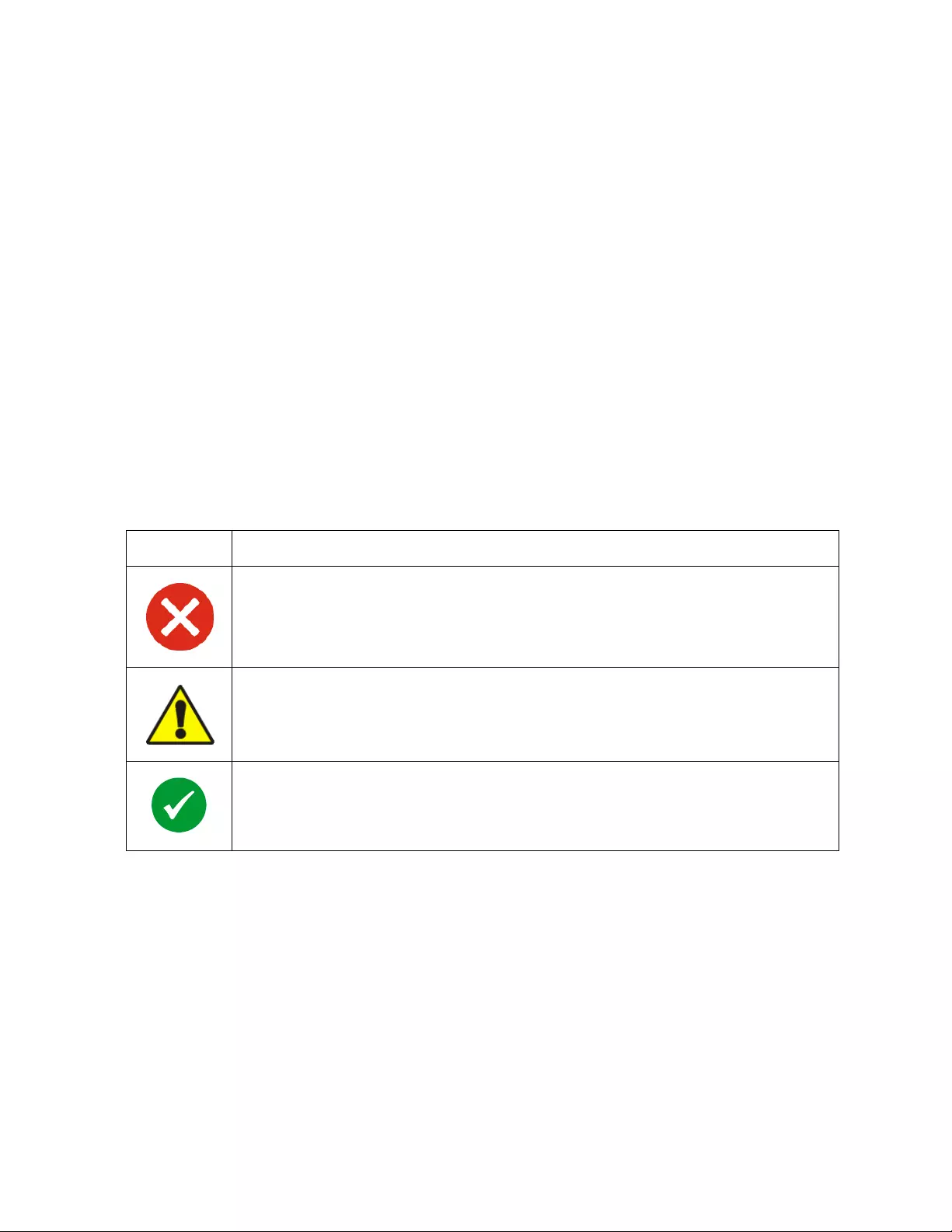
Metered Smart PDU User Guide43
Web Interface Features
Read the following to familiarize yourself with basic Web interface features for your Smart PDU.
Tabs
The following tabs are available:
• Home: Appears when you log on. View active alarms, the load status of the Smart PDU, and
the most recent Smart PDU events. For more information, see “About the Home Tab” on
page 45.
• Device Manager: View the load status for the Smart PDU, configure load thresholds, and view
and manage the peak load measurement. For more information, see “About the Device
Manager Tab” on page 46.
• Environment: View temperature and humidity sensor data, if a sensor is connected to the Smart
PDU.
• Logs: View event, data, and system logs.
• Administration: Configure security, network connection, notification, and general settings.
Device status icons
One or more icons and accompanying text indicate the current operating status of the Smart PDU:
At the upper right corner of every page, the Web interface displays the same icons currently displayed on
the Home page to report Smart PDU status:
• The No Alarms icon if no alarms exist.
• One or both of the other icons (Critical and Warning) if any alarms exist, and after each icon, the
number of active alarms of that severity.
To return to the Home tab to view its summary of the Smart PDU status, including the active alarms,
click a quick status icon on any page of the interface.
Symbol Description
Critical: A critical alarm exists, which requires immediate action.
Warning: An alarm condition requires attention and could jeopardize your data or equipment if
its cause is not addressed.
No Alarms: No alarms are present, and the Smart PDU and NMC are operating normally.

44Metered Rack PDU User Guide
Quick Links
At the lower left on each page of the interface, there are three configurable links. By default, the links
access the URLs for these Web pages:
• Link 1: The home page of the APC Web site
• Link 2: Demonstration s of APC Web - enabled products
• Link 3: Information on APC Remote Monitoring Services.
To reconfigure the links, see “Configure Links” on page 79.
Other Web interface features
• The IP address appears in the upper left corner.
• A context-sensitive Help link and Log off link are located in the upper right corner.
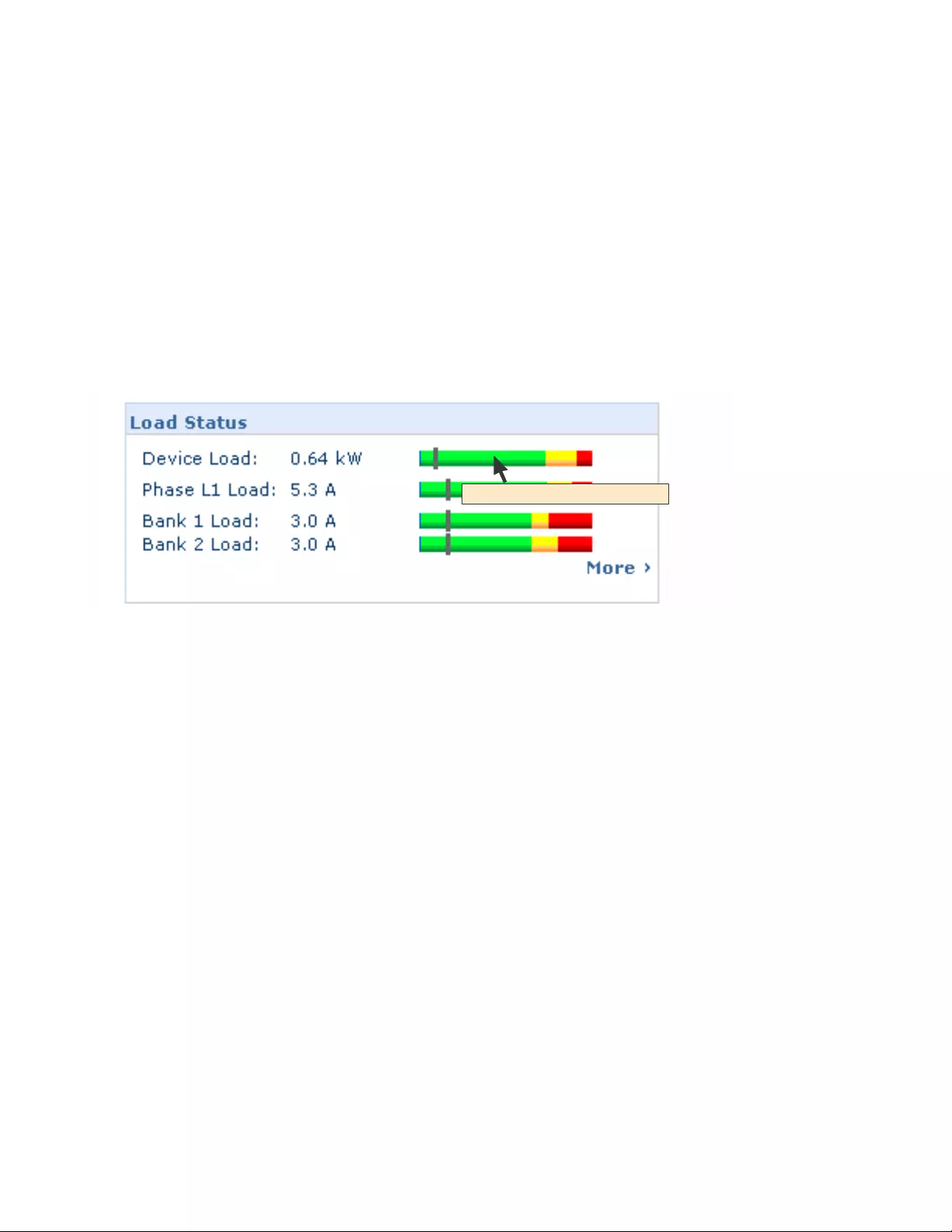
Metered Smart PDU User Guide45
About the Home Tab
Use the Home tab to view active alarms, the load status of the Smart PDU, and the most recent Smart
PDU events.
The Overview view
Path: Home > Overview
The top of the Overview indicates the alarm status. If one or more alarms are present, the number and
type of alarms are indicated with a link to the Alarm Status view, where you can view descriptions of
each alarm. If no alarms exist, the Overview displays, “No Alarms Present.”
In the Load Status area, view the load for the device in kW and for the phases and banks in amps, as
applicable. The green, yello w, and red meter shows the current load status: normal, near overload, or
overload. Note that if a low load threshold was configured the meter will also include a blue segment to
the left of the green. Hover over the colors to view the configured load thresholds.
Click More to go to the Device Manager tab to configure thresholds and to view and manage p eak load
information.
In the device parameters area, view the name, contact, location, current rating, type of user account
accessing the Smart PDU, and the amount of time the Smart PDU has been operating since the last
reboot from either a power cycle or a reboot of the Management Interface. [For more information, see
“Reset the Smart PDU” on page 78.]
In the Recent Device Events area, view, in reverse chronological order, the events that occurred most
recently and the dates and times they occurred. A maximum of five events are shown at one time. Click
More Events to go to the Logs tab to view the entire event log.
The Alarm Status view
Path: Home > Alarm Status
The Alarm Status view provides a description of all alarms present. For details about a temperature or
humidity threshold viola tion, click the Environment tab.
Normal range is 0.0 to 5.9 kW

46Metered Rack PDU User Guide
Device Management
About the Device Manager Tab
Path: Device Manager
Use the Device Manager tab to:
• View the load status for the Smart PDU
• Configure load thresholds for all connected devices, phases, and banks as applicable
• Configure a name and location for the Smart PDU
• View and manage the peak load measurement
Viewing the Load Status and Peak Load
Path: Device Manager > Load Management options
Use the Load Management menu options to view the load for the device, phases, and banks. The
indicator in the green, yellow, and red meter shows the current load status: normal, near overload, or
overload. If a low load threshold was configured, the meter will include a blue segment to the left of the
green. When viewing the Device Load, the triangle above the meter indicates peak load.
Configuring Load Thresholds
Path: Device Manager > Load Management options
Note: The Smart PDU generates an alarm when any bank exceeds its rated value. However, if a circuit
breaker trips, there is no definitive indication that the circuit breaker is open, other than that the current
for that bank will drop. Set the Low Load Warning Threshold to 1 amp for these reasons:
• The default setting for the Low Load W arning Thr eshold is 0 amps. This ef fectively disables the
warning. With a setting of 0 amps for the Low Load Warning Thr eshold, the Web interface will
not indicate that a circuit breaker may have tripped.
• A 1-amp detection threshold for the Low Load Warning for Bank Load Management will help to
indicate that a circuit breaker may have tripped.
To configure load thresholds:
1. Click the Device Manager tab.
2. To configure load thresholds for the device, phases, or banks, make a selection from the Load
Management menu.
3. Set Overload Alarm, Near Overload Warning, and Low Load Warning thresholds.
4. Click Apply.

Metered Smart PDU User Guide47
Configure the Name and Location of the Smart PDU
Path: Device Manager > Device Load
The name and location you enter appear on the Home tab.
Note: You can set the Name and Location through either the Device Manager tab or th e Ad mi nistration
tab. A change in one affects the other.
1. Click the Device Manager tab, then device load from the Load Management menu.
2. Enter a name and location.
3. Click Apply.
Resetting Peak Load and kWh
Path: Device Manager > Device Load
1. Click the Device Manager tab, then device load from the Load Management menu.
2. Click the Peak Load and Kilowatt-Hours check boxes as desired.
3. Click Apply.

48Metered Rack PDU User Guide
Environment
Configure Temperature and Humidity Sensors
Path: Environment
Through the Environment tab, when you have a temperature or a temperature and humidity sensor
connected to the Smart PDU, you can set thresholds for Warning and Critical alarm generation (see
“Device status icons” on pa ge 43 for details on each type of ala rm) .
For temperature:
• If the high temperature threshold is reached, the system generates a Warning alarm.
• If the maximum temperature threshold is reached, the system generates a Critical alarm.
Similarly, for humidity:
• If the low humidity threshold is reached, the system generates a Warning alarm.
• If the minimum humidity threshold is reached, the system generates a Critical alarm.
Note: Click the thermometer symbol in the upper right corner to toggle between Fahrenheit and
Celsius.
To configure temperature and humidity sensors:
1. Enter values for minimum, maximum, high, and low thresholds.
2. Enter Hysteresis values. (See “Hysteresis” on page 48 for details.)
3. Enable alarm generatio n as desired.
4. Click Apply.
Hysteresis. This value specifies how far past a threshold the temperature or humidity must return to
clear a threshold violation.
• For Maximum and High temperature threshold violations, the clearing point is the threshold
minus the hysteresis.
• For Minimum and Low humidity threshold violations, the clearing point is the threshold plus the
hysteresis.
Increase the value for Temperature Hysteresis or Humidity Hysteresis to avoid multiple alarms if
temperature or humidity that has caused a violation then wavers slightly up and do wn. If the hysteresis
value is too low, such wavering can cause and clear a threshold violation repeatedly.
Example of rising but wavering temperature: The maximum temperature threshold is 85°F, and the
temperature hysteresis is 3°F. The temperature rises above 85°F, violating the threshold. It then wavers
down to 84°F and then up to 86°F repeatedly, but no clearing event and no new violation occur. For the
existing violation to clear, the temperature would have to drop to 82°F (3°F below the threshold).
Example of falling but wavering humidity: The minimum humidity thresho ld is 18%, and the humidity
hysteresis is 8%. The humidity falls below 18%, violating the threshold. It then wavers up to 24% and
down to 13% repeatedly, but no clearing event and no new violation occur. For the existing violation to
clear, the humidity would have to rise to above 26% (8% past the threshold).

Metered Smart PDU User Guide49
Logs
Use the Event and Data Logs
Event log
Path: Logs > Events > options
You can view, filter, or delete the event log. By default, the log displays all events recorded during the
last two days in reverse chronological order.
For lists of all configurable events and their current configuration, select the Administration tab,
Notification on the top menu bar, and by event under Event Actions on the left navigation menu. See
“Configuring by event” on page 70.
To display the event log (Logs > Events > log):
• By default, view the event log as a page of the Web interface. The most recent event is recorded
on page 1. In the navigation bar below the log:
– Click a page number to open a specific page of the log.
– Click Previous or Next to view the events recorded immediately before or after the events
listed on the open page.
– Click << to return to the first page or click >> to view the last page of the log.
• To see the listed events on one page, click Launch Log in New Window from the event log page
to display a full-screen view of the log.
Note: In your browser's options, JavaScript® must be enabled for you to use the Launch Log in
New Window button.
You can also use FTP or Secure CoPy (SCP) to view the event log. See “How to use FTP or SCP to
retrieve log files” on page 53.

50Metered Rack PDU User Guide
To filter the log (Logs > Events > log):
• Filtering the log by date or time: To display the entire event log, or to change the number of
days or weeks for which the log displays the most recent events, select Last. Select a time range
from the drop-down menu, then click Apply. The filter configuration is saved until the Smart
PDU restarts.
To display events logged during a specific time range, select From. Specify the beginning and
ending times (using the 24-hour clock format) and dates for which to display events, then click
Apply. The filter configuration is saved until the Smart PDU restarts.
• Filtering the log by event: To specify the events that display in the log, click Filter Log. Clear
the checkbox of an event category or alarm severity level to remove it from view. Text at the
upper right corner of the event log page indicates that a filter is active.
As Administrator, click Save As Default to save this filter as the default log view for all users. If
you do not click Save As Default, the filter is active until you clear it or until the Smart PDU
restarts.
To remove an active filter, click Filter Log, then Clear Filter (Show All).
Note: Events are processed through the filter using OR logic.
Events that you do not select from the Filter By Severity list never display in the filtered event
log, even if the event occurs in a category you selected from the Filter by Category list.
Events that you do not select from the Filter by Category list never display in the filtered event
log, even if devices in the category enter an alarm state you selected from the Filter by Severity
list.
To delete the log (Logs > Events > log):
To delete all events recorded in the log, click Clear Log on the Web page that displays the log. Deleted
events cannot be retrieved. To disable the logging of ev ents based on their assigned severity level or their
event category, see “Configuring by event” on page 70.
To configure reverse lookup (Logs > Events > reverse lookup):
Reverse lookup is disabled by default. Enable this feature unless you have no DNS server configured or
have poor network performance because of heavy network traffic.
With reverse lookup enabled, when a network-related event occurs, both the IP address and the domain
name for the networked device associated with the event are logged in the event log. If no domain name
entry exists for the device, only its IP address is logged with the event. Since domain names generally
change less frequently than IP addresses, enabling reverse lookup can improve the ability to identify
addresses of networked devices that are causing events.
To resize the event log (Logs > Events > size):
By default, the event log stores 400 events. You can change the number of events the log stores. When
you resize the event log, all existing log entries are delete d. To avoid losing log data, use FTP or SCP to
retrieve the log before you enter a new value in the Event Log Size field. See “How to use FTP or SCP
to retrieve log files” on page 53.
When the log is full, the older entries are deleted.
Network Port Sharing Event Logs and Traps.
Smart PDU events from guest PDUs are sent to the host PDU for inclusion into its log. The log entry
will include the Display ID of the unit that the event occurred on.
These events are then handled the same as local events from the host PDU. Therefore alarms, SNMP
traps, e-mails, Syslog, etc will support Smart PDU events and alarms from all Smart PDUs in a group.
Example event log: Smart PDU 4: Device low load.
Note: System events will only be logged for the host PDU. System events from guest PDUs will not be
logged on the host PDU.

Metered Smart PDU User Guide51
Data log
Path: Logs > Data > options
The data log records the current and power for the device, phase, and banks, as well as temperature and
humidity at the specified time interval. Each entry is listed by the date and time the data was recorded.
To display the data log (Logs > Data > log):
• By default, view the data log as a page of t he Web interface. The most recent data item is recorded
on page 1. From the navigation menu below the log:
– Click a page number to open a specific page of the log.
– Click Previous or Next to view the data recorded immediately before or after the data that is
listed on the open page.
– Click << to return to the first page of the log, or click >> to view the last page of the log.
• To see the listed data on one page, click Launch Log in New Window from the data log page to
display a full-screen view of the log.
Note: In your browser's options, JavaScript must be enabled for you to use the Launch Log in
New Window button.
Alternatively, you can use FTP or SCP to view the data log. See “How to use FTP or SCP to retrieve log
files” on page 53.
To filter the log by date or time (Logs > Data > log):
To display the entire data log or to change the number of da ys or weeks for which the log dis play s the
most recent events, select Last. Select a time range from the drop-down menu, then click Apply. The
filter configuration is saved until the device restarts.
To display data logged during a specific time range, select From. Specify the beginning and ending
times (using the 24-hour clock format) and dates for which to display data, then click Apply. The filter
configuration is saved until the device restarts.
To delete the data log:
To delete all data recorded in the log, click Clear Data Log on the Web page that displays the log.
Deleted data cannot be retrieved.
To set the data collection interval (Logs > Data > interval):
Define, in the Log In ter val setting, how frequently data is sampled and stored in the data log, and view
the calculation of how many days of data the log can store, based on the interval you selected. When the
log is full, the older entries are deleted. To avoid automatic deletion of older data, enable and configure
data log rotation, described in the next section.

52Metered Rack PDU User Guide
To configure data log rotation (Logs > Data > rotation):
Set up a password-protected data log repository on a specified FTP server. Enabling rotation causes the
contents of the data log to be appended to the file you specify by name and location. Updates to this file
occur at the upload interval you specify.
To resize the data log (Logs > Data > size):
By default, the data log stores 500 records. You can change the number of records the log stores. When
you resize the data log, all existing log records are deleted. To avoid losing records, use FTP or SCP to
retrieve the log before you enter a new value in the Data Log Size field. See “How to use FTP or SCP to
retrieve log files” on page 53.
When the log is full, the older entries are deleted.
Network Port Sharing Dat a Log:
The host Smart PDU will poll data from guest PDUs so that da ta from all PDUs in a group are available.
To view data from a different Smart PDU in a group, select the desired Smart PDU from the "Filter Log"
pull-down list.
Similarly for data log graphing, you can select a different Smart PDU by clicking on the "Change Data
Filter" button.
Parameter Description
Data Log Rotation Enable or disable (the defau lt) data log rotation.
FTP Server Address The location of the FTP server where the data repository file is stored.
User Name The user name required to send data to the repository file. This user must also
be configured to have read and write access to the data repository file and the
directory (folder) in which it is stored.
Password The password required to send data to the repository file.
File Path The path to the repository file.
Filename The name of the repository file (an ASCII text file).
Delay X hours between
uploads The number of hours between uploads of data to the file.
Upload every X minutes The number of minutes between attempts to upload data to the file after an
upload failure.
Up to X times The maximum number of times the upload will be attempted after an initial
failure.
Until Upload Succeeds Attempt to upload the file until the transfer is completed.

Metered Smart PDU User Guide53
How to use FTP or SCP to retrieve log files
An Administrator or Device User can use FTP or SCP to retrieve a tab-delineated event log file
(event.txt) or data log file (data.txt) and import it into a spreadsheet.
• The file reports all events or data recorded since the log was last deleted or (for the data log)
truncated because it reached maximum size.
• The file includes information that the event log or data log does not display.
– The version of the file format (first field)
– The date and time the file was retrieved
–The Name, Contact, and Location values and IP address of the Smart PDU
– The unique Event Code for each recorded event (event.txt file only)
Note: The Smart PDU uses a four-digit year for log entries. You ma y need to select a four-
digit date format in your spreadsheet application to display all four digits.
If you are using the encryption-based security protocols for your system, use SCP to retrieve the log file.
If you are using unencrypted authentication methods for the security of your system, use FTP to retrieve
the log file.
See the Security Handbo ok, available at www.apc.com, for information on available protocols and
methods for setting up the type of security you need.
To use SCP to retrieve the files. To use SCP to retrieve the event.txt file:
scp username@hostname_or_ip_address:event.txt ./event.txt
To use SCP to retrieve the data.txt file, use the following command:
scp username@hostname_or_ip_address:data.txt ./data.txt
To use FTP to retrieve the files. To use FTP to retrieve the event.txt or data.txt file:
1. At a command prompt, type ftp and the IP address of the Smart PDU, and press ENTER.
If the Port setting for the FTP Server option (set through the Network menu of the
Administration tab) has been changed from its default (21), you must use the non-default
value in the FTP command. For Windows FTP clients, use the following command, including
spaces. (For some FTP clients, you must use a colon instead of a space between the IP address
and the port number.)
ftp>open ip_address port_number
To set a non-default port value to enhance security for the FTP Server, see “FTP Server” on
page 68. You can specify any port from 5001 to 32768.
2. Use the case-sensitive User Name and Password for Administrator or Device User to log on. For
Administrator, apc is the default for User Name and Password. For the Device User , the defaults
are device for User Name and apc for Password.
3. Use the get command to transmit the text of a log to your local drive.
ftp>get event.txt
or
ftp>get data.txt
4. Type quit at the ftp> prompt to exit from FTP.

54Metered Rack PDU User Guide
Administration: Security
Local Users
Setting user access
Path: Administration > Security > Local Users > options
The Administrator user account always has access to the Smart PDU.
The Device User and Read-Only User accounts are enabled by default. To disable the Device User or
Read-Only User accounts, select the user account from the left navigation menu, then clear the Enable
checkbox.
You set the case-sensitive user name and password for each account type in the same manner. Maximum
length is 64 characters for a user name and 64 characters for a password. Blank passwords (passwords
with no characters) are not allowed.
For information on the permissions granted to each account type (Administrator, Device User, and Read-
Only User), see “Types of User Accounts” on page 2.
Remote Users
Authentication
Path: Administration > Security > Remote Users > Authentication Method
Use this option to select how to administer remote access to the Smart PDU.
For information about local authentication (not using the centralized authentication of a RADIUS
server), see the Security Handbook, available at www.apc.com.
The authentication and authorization functions of RADIUS (Remote Authentication Dial-In User
Service) is supported.
• When a user accesses the Smart PDU or other network-enabled device that has RADIUS enabled,
an authentication request is sent to the RADIUS se rver to determine the User permission level.
• RADIUS user names used with the Smart PDU are limited to 32 characters.
Account Type Default User Name Default Password Permitted Acces s
Administrator apc apc Web interface and command
line interface
Device User device apc
Read-Only User readonly apc Web interface only

Metered Smart PDU User Guide55
Select one of the following:
• Local Authentication Only: RADIUS is disabled. Local authentication is enabled.
• RADIUS, then Local Authentication: RADIUS and local authentication are enabled.
Authentication is requested from the RADIUS server first. If the RADIUS server fails to respond,
local authentication is used.
• RADIUS Only: RADIUS is enabled. Local authentication is disabled.
Note: If RADIUS Only is selected, and the RADIUS server is unavailable, or improperly
configured, remote access is unavailable to all users. You must use a serial connection to the
command line interface and change the access setting to local or radiusLocal to regain access.
For example, the command to change the access setting to local would be: radius -a local
RADIUS
Path: Administration > Security > Remote Users > RADIUS
Use this option to do the following:
• List the RADIUS servers (a maximum of two) available to the Smart PDU and the time-out period
for each.
• Click on a link, and configure the parameters for authentication by a new RADIUS server.
• Click a listed RADIUS server to display and modify its parameters.
RADIUS Setting Definition
RADIUS Server The server name or IP address (IPv4 or IPv6) of the RADIUS server. Click on a
link to configure the server.
Note:RADIUS servers use port 1812 by default to authenticate users. Non-stan-
dard ports are currently unsupported.
Secret The shared secret between the RADIUS server and the Smart PDU.
Timeout The time in seconds that the Smart PDU waits for a response from the RADIUS
server.
Test Setting s Enter the Administrator user name and password to test the RADIUS server path
that you have configured.
Skip Test and Apply Do not test the RADIUS server path.

56Metered Rack PDU User Guide
Configure the RADIUS Server
Summary of the configuration procedure
You must configure your RADIUS server to work with the Smart PDU.
For examples of the RADIUS users file with Vendor Specific Attributes (VSAs) and an example of an
entry in the dictionary file on the RADIUS server, see the Security Handbook.
1. Add the IP address of the Smart PDU to the RADIUS server client list (file).
2. Users must be configured with Service-Type attributes unless Vendor Specific Attributes (VSAs)
are defined. If no Service-Type attributes are configured, users will have read-only access (on the
Web interface only).
See your RADIUS server documentation for information about the RADIUS users file, and see
the Security Handbook for an exa mple.
3. VSAs can be used instead of the Service-Type attributes provided by the RADIUS server. VSAs
require a dictionary entry and a RADIUS users file. In the dictionary file, define the names for
the ATTRIBUTE and VALUE keywords, but not for the numeric values. If you change numeric
values, RADIUS authentication and authorization will fail. VSAs take precedence over standard
RADIUS attributes.
Configuring a RADIUS server on UNIX® with shadow passwords
If UNIX shadow password files are used (/etc/passwd) with the RADIUS dictionary files, the following
two methods can be used to authenticate users:
• If all UNIX users have administrative privileges, add the following to the RADIUS “user” file. To
allow only Device Users, change the APC-Service-Type to Device.
DEFAULT Auth-Type = System
APC-Service-Type = Admin
• Add user names and attributes to the RADIUS “user” file, and verify the password against /etc/
passwd. The following example is for users bconners and thawk:
bconners Auth-Type = System
APC-Service-Type = Admin
thawk Auth-Type = System
APC-Service-Type = Device
Supported RADIUS servers
FreeRADIUS and Microsoft IAS 2003 are supported. Oth er co mm on ly available RADIUS applications
may work but have not been fully tested.
RADIUS and Network Port Sharing
Note: See the Security Handbook for APC Network Management Cards for more information on using
RADIUS.

Metered Smart PDU User Guide57
Inactivity Timeout
Path: Administration > Security > Auto Log Off
Use this option to configure the time (3 minutes by default) that the system waits before logging off an
inactive user. If you change this value, you must log off for the change to take effect.
Note: This timer continues to run if a user closes the browser window without first logging off by
clicking Log Off at the upper right. Because that user is still considered to be logged on, no user can log
on until the time specified as Minutes of Inactivity expires. For example, with the default value for
Minutes of Inactivity, if a user closes the browser window without loggin g off, no user can log on for 3
minutes.

58Metered Rack PDU User Guide
Administration: Network Features
TCP/IP and Communication Settings
TCP/IP settings
Path: Administration > Network > TCP/IP
The TCP/IP option on the left navigation menu, selected by default when you choose Network on the
top menu bar, displays the current IPv4 address, subnet mask, default gateway, MAC add r ess, and boot
mode of the Smart PDU. For information on DHCP and DHCP options, se e RFC2131 and RFC2132.
Setting Description
Enable Enable or disable IPv4 wi th this check box.
Manual Configure IPv4 manually by entering the IP address, subnet mask, and default gateway.
BOOTP A BOOTP server provides the TCP/IP settings. At 32-second intervals, the Smart PDU requests
network assignment from any BOOTP server:
• If the Smart PDU receives a valid response, it starts the network services.
• If the Smart PDU finds a BOOTP server, but a request to that server fails or times out, the Smart
PDU stops requesting network settings until it is restarted.
• By default, if previously configured network settings exist, and the Smart PDU receives no valid
response to five requests (the original and fo ur retri es), it uses the previously configured settings
so that it remains accessible.
Click Next>> to access the BOOTP Configuration page to change the number of retries or the
action to take if all retries fail :1
•Maximum retries: Enter the number of retries that will occur when no valid response is received,
or zero (0) for an unlimited number of retries.
•If retries fail: Select Use prior settings (the default) or Stop BOOTP request.
DHCP The default setting . At 32-secon d intervals, the Sm art PDU requests network assignment from any
DHCP server.
• If the Smart PDU receives a valid response, it does not (as previously) require the APC cookie
from the DHCP server in order to accept the lease and start the network services.
• If the Smart PDU finds a DHCP server, but the request to that server fails or times out, it stops
requesting network settings until it is restarted.1
•Require vendor specific cookie to accept DHCP Address: By selecting this check box, you can
require the DHCP server to provide a cookie which supplies in formation to the Smart PDU.
1. The default values for these three settings on the configuration pag e s generally do not need to be changed:
•Vendor Class: APC
•Client ID: The MAC address of the Smart PDU, which uniquely identifies it on the local area network
(LAN)
•User Class: The name of the application firmware module

Metered Smart PDU User Guide59
DHCP response options
Each valid DHCP response contains options that provide the TCP/IP settings that the Smart PDU needs
to operate on a network, and other information that affects the operation of the Smart PDU.
Vendor Specific Information (option 43). The Smart PDU uses this option in a DHCP response to
determine whether the DHCP response is valid. This option contains an APC-specific options in a TAG/
LEN/DATA format, called the APC Cookie. This is disabled by default.
• APC Cookie. Tag 1, Len 4, Data “1APC”
Option 43 communicates to the Smart PDU that a DHCP server is configured to service
devices.
Following, in hexadecimal format, is an exam ple o f a Vendor Specific Information option that
contains the APC cookie:
Option 43 = 0x01 0x04 0x31 0x41 0x50 0x43
TCP/IP options. The Smart PDU uses the following options within a valid DHCP response to define its
TCP/IP settings. All of these options except the first are described in RFC2132.
• IP Address (from the yiaddr field of the DHCP response, described in RFC2131): The IP
address that the DHCP server is leasing to the Smart PDU.
• Subnet Mask (option 1): The Subnet Mask value that the Smart PDU needs to operate on the
network.
• Router, i.e., Default Gateway (option 3): The default gateway address that the Smart PDU needs
to operate on the network.
• IP Address Lease Time (option 51): The time duration for the lease of the IP Address to the
Smart PDU.
• Renewal Time, T1 (option 58): The time that the Smart PDU must wait after an IP address lease
is assigned before it can request a renewal of that lease.
• Rebinding Time, T2 (option 59): The time that the Smart PDU must wait after an IP address
lease is assigned before it can seek to rebind that lease.
Other options. The Smart PDU also uses these options within a valid DHCP response. All of these
options except the last are described in RFC2132.
• Network Time Protocol Servers (option 42): Up to two NTP servers (primary and secondary)
that the Smart PDU can use.
• Time Offset (option 2): The offset of the Smart PDU's subnet, in seconds, from Coordinated
Universal Time (UTC).
• Domain Name Server (option 6): Up to two Domain Name System (DNS) servers (primary and
secondary) that the Smart PDU can use.
• Host Name (option 12): The host name that the Smart PDU will use (32-character maximum
length).
• Domain Name (option 15): The domain name that the Smart PDU will use (64-character
maximum length).
• Boot File Name (from the file field of the DHCP response, described in RFC2131): The fully
qualified directory-path to a user configuration file (.ini fi le) to download. The siaddr field of the
DHCP response specifies the IP address of the server from which the Smart PDU will download
the .ini file. After the download, the .ini file is used as a boot file to reconfigure the settings.

60Metered Rack PDU User Guide
Path: Administration > Network > TCP/IP > IPv6 settings
Port Speed
Path: Administration > Network > Port Speed
The Port Speed setting defines the communicatio n sp eed of the TCP/IP port.
• For Auto-negotiation (the default), Ethernet devices negotiate to transmit at the highest possible
speed, but if the supported speeds of two devices are unmatched, the slower speed is used.
• Alternatively, you can choose 10 Mbps or 100 Mbps, each with the option of half-duplex
(communication in only on e direc tion at a time) or full-duplex (communication in both directions
on the same channel simultaneously).
Ping Response
Path: Administration > Network > Ping Response
• Select the Enable check box for IPv4 Ping Response to allow the NMC to respond to network
pings. Clear the check box to disable an NMC response. This does not apply to IPv6.
Setting Description
Enable Enable or disable IPv6 with this check box.
Manual Configure IPv6 manually by entering the IP address and the default gateway.
Auto
Configuration When the Auto Configuration check box is selected, the system obtains addressing prefixes
from the router (if available). It uses those prefixes to automatically configure IPv6 addresses.
DHCPv6
Mode Router Controlled: Selecting this option means th at DHCPv6 is controlled by the
Managed(M) and Other(O) flags received in IPv6 router advertisements. When a router
advertisement is received, the NMC checks whether the M or the O flag is set. The NMC
interprets the state of the M (Managed Address Configuration Flag) and O (Other Stateful
Configuration Flag) "bits" for the following cases:
•Neither is set: Indicates the local network has no DHCPv6 infrastructure. The NMC uses
router advertisements and manual configuration to get addresses that are not link-local and
other settings.
•M, or M and O ar e set : In this situation, full DHCPv6 address configuration occurs. DHCPv6
is used to obtain addresses AND other configuration settings. This is known as DHCPv6
stateful. Once the M flag has been received, the DHCPv6 address configuration stays in
effect until the interface in question has been closed. This is true even if subsequent router
advertisement packets are received in which the M flag is not set.
If an O flag is received first, then an M flag is received subsequently, the NMC performs full
address configuration upon receipt of the M flag
•Only O is set: In this situation, the NMC sends a DHCPv6 Info-Request packet. DHCPv6 will
be used to configure “other” settings (such as location of DNS servers), but NOT to provide
addresses. This is known as DHCPv6 stateless.
Address and Other Information: With this radio box selected, DHCPv6 is used to obtain
addresses AND other configuration settin gs. This is known as DHCPv6 stateful.
Non-Address Information Only: With this radio box selected, DHCPv6 will be used to
configure "other" settings (such as location of DNS servers), but NOT to provide addresses.
This is known as DHCPv6 stateless.
Never: Select this to disable DHCPv6.

Metered Smart PDU User Guide61
DNS
Path: Administration > Network > DNS > options
Use the options under DNS to configure and test the Domain Name System (DNS):
• Select Primary DNS Server or Secondary DNS Server to specify the IPv4 or IPv6 addresses of the
primary and optional secondary DNS server. For the Smart PDU to send e-mail, you must at least
define the IP address of the primary DNS server.
– The Smart PDU waits up to 15 seconds for a response from the primary DNS server or
secondary DNS server (if specified). If the Smart PDU does not receive a response within that
time, e-mail cannot be sent. Use DNS servers on the same segment as the Smart PDU or on a
nearby segment (but not across a wide-area network [WAN]).
– Define the IP addresses of the DNS servers then enter the DNS name of a computer on your
network to look up the IP address for that computer to verify correct operation.
• Host Name: Configure a host name here and a domain name in the Domain Name field then
users can enter a host name in any field in the NMC interface (except e-mail addresses) that
accepts a domain name.
• Domain Name (IPv4): Configure the domain name here only. In all other fields in the NMC
interface (except e-mail addresses) that accept domain names, the NMC adds this domain name
when only a host name is entered.
– To override all instances of the expansion of a specified host name by the addition of the
domain name, set the domain name field to its default, somedomain.com, or to 0.0.0.0.
– To override the expansion of a specific host name entry, include a trailing period. The NMC
recognizes a host name with a trailing period (such as mySnmpServer.) as if it were a fully-
qualified domain name and does not append the domain name.
• Domain Name (IPv6): Specify the IPv6 domain name here.
• Select test to send a DNS query that tests the setup of your DNS servers:
–As Query Type, select the method to use for the DNS query:
•by Host: the URL name of the server
•by FQDN: the fully-qualified domain name
•by IP: the IP address of the server
•by MX: the Mail Exchange used by the server
–As Query Question, identify the value to be used for the selected query type:
– View the result of the test DNS request in the Last Query Response field.
Query Type Selected Query Question to Use
by Host The URL
by FQDN The fully qualified domain name, my_server.my_domain
by IP The IP address
by MX The Mail Exchange address

62Metered Rack PDU User Guide
Web
Path: Administration > Network > Web > options
Option Description
access To activate changes to any of these selections, log off from the Smart PDU:
•Disable: Disables access to the Web interface. (To re-enable access, log in to the command line
interface, then type the command http -S enable. For HTTPS access, type https -S
enable.)
•Enable HTTP (the default): Enables Hypertext Transfer Protocol (HTTP), which provides
Web access by user name and password, but does not encrypt user names, passwords, and data
during transmission.
•Enable HTTPS: Enables Hypertext Transfer Protocol (HTTPS) over Secure Sockets Layer
(SSL). SSL encrypts user names, passwords, and data during transmission, and authenticates the
Smart PDU by digital certificate. When HTTPS is enabled, your browser displays a small lock
icon.
See “Creating and Installing Digital Certificates” in the Security Handbook, available at
www.apc.com.
HTTP Port: The TCP/IP port (80 by default) used to communicate by HTTP with the Smart
PDU.
HTTPS Port: The TCP/IP port (443 by default) used to communicate by HTTPS with the Smart
PDU.
For either of these ports, you can change the port setting to any unused port from 5000 to 32768
for additional security. Users must then use a colon (:) in the address field of the browser to specify
the port number. For exam ple, for a port number of 5000 and an IP address of 152.214.12.114:
http://152.214.12.114:5000
https://152.214.12.114:5000
ssl
certificate Add, replace, or remove a security certificate.
Status:
•Not installed: A certificate is not installed, or was installed by FTP or SCP to an incorrect
location. Using Add or Replace Certificate File installs the certificate to the correct location,
/ssl on the Smart PDU.
•Generating: The Smart PDU is generating a certificate because no valid certificate was found.
•Loading: A certificate is being activated on the Smart PDU.
•Valid certificate: A valid certificate was installed or was generated by the Smart PDU. Click
on this link to view the contents of the certificate.
If you install an invalid certificate, or if no certificate is loaded when you enable
SSL, the Smart PDU generates a default certificate, a process which delays access to
the interface for up to one minute. You can use the default certificate for basic encryption-
based security, but a security alert message displ ays whenever you log on.
Add or Replace Certificate File: Enter or browse to the certificate file created with the
Security Wizard.
See “Creating and Installing Digital Certificates” in the Security Handbook, available at
www.apc.com, to choose a method for using digital certificates created by the Security W izard or
generated by the Smart PDU.
Remove: Delete the current certificate.

Metered Smart PDU User Guide63
Console
Path: Adm inis tra tion > Network > Conso le >
options
Note: To use SSH, you must have an SSH client installed. Most Linux and other UNIX platforms
include an SSH client, but Microsoft Windows operating systems do not. Clients are available from
various vendors.
Option Description
access Choose one of the following for access by Telnet or Secure SHell (SSH):
•Disable: Disables all access to the command line interface.
•Enable Telnet (the default): Telnet transmits user names, passwords, and data without
encryption.
•Enable SSH: SSH transmits user names, passwords, and data in encrypted form, provi ding
protection from attempts to intercept, forge, or alter data during transmission.
Configure the ports to be used by these protocols:
•Telnet Port: The Telnet port used to communicate with the Smart PDU (23 by default). You can
change the port setting to any unused port from 5000 to 32768 for additional security . Users must
then use a colon (:) or a space, as required by your Telnet client program, to specify the non-
default port. For example, for port 5000 and an IP address of 152.214.12.114, your Telnet client
requires one of the these commands:
telnet 152.214.12.114:5000
telnet 152.214.12.114 5000
•SSH Port: The SSH port used to communicate with the Smart PDU (22 by default). You can
change the port setting to any unused po rt from 5000 to 32768 for additional security. See the
documentation for your SSH client for the command line format required to specify a non-default
port.
ssh host
key Status indicates the status of the host key (private key):
•SSH Disabled: No host key in use: When disabled, SSH cannot use a host key.
•Generating: The Smart PDU is creating a host key because no valid host key was found.
•Loading: A host key is being activated on the Smart PDU.
•Valid: One of the follow ing valid host keys is in the /ssh directory (the required location on the
Smart PDU):
•A 1024-bit or 2048-bit host key created by the Security Wizard
•A 2048-bit RSA host key generated by the Smart PDU
Add or Replace: Browse to and upl oad a host key file created by the Security Wizard.
To use the APC Security Wizard, see the Security Handbook, available at www.apc.com.
Note:To reduce the time required to enable SSH, create and upload a host key in advance. If you
enable SSH with no host key loaded, the Smart PDU takes up to one minute to create a
host key, and the SSH server is not accessible during that time.
Remove: Remove the current host key.

64Metered Rack PDU User Guide
SNMP
All user names, passwords, and community names for SNMP are transferred over the network as plain
text. If your network requires the high security of encryption, disable SNMP access or set the access for
each community to Read. (A community with Read access can receive status information and use SNMP
traps.)
When using StruxureWare Data Center Expert to manage a Smart PDU on the public network of an
StruxureWare Data Center Expert system, you must have SNMP enabled in the Smart PDU interface.
Read access will allow the StruxureWare Da ta Center Expert device to receive traps from the Smart
PDU, but Write access is required while you use the interface of the Smart PDU to set the StruxureWare
Data Center Expert device as a trap receiver.
For detailed information on enhancing and managing the security of your system, see the Security
Handbook, available at www.apc.com.
Network Port Sharing.
All Smart PDUs in a group can be accessed through the Host Smart PDU via SNMP "rPDU2" OIDs
available in our PowerNet-MIB.
The full path to these OIDs is:
iso(1).org(3).dod(6).internet(1).private(4).enterprises(1).apc(318).products(1).hardware(1).rPDU2(26)
Individual Smart PDUs can be identified in the SNMP MIB tables by viewing the corresponding
"Module" OIDs in each table. These Module OIDs will return the Display ID of the Smart PDU.
Example Module OIDs: rPDU2IdentModule, rPDU2DeviceConfigModule,
rPDU2SensorTempHumidityConfigModule
In order to be backwards compatible with previous versions, the Host Smart PDU will always be the first
index in any table that supports multiple Smart PDUs. In addition, after the Smart PDU group is set up,
the index order of guest Smart PDUs should not change even if the Display ID is changed or a PDU
temporarily loses communication. The index order should only change if you manually remove a Smart
PDU from the group.
An MIB table walk should skip the indexes associated with a Smart PDU that has temporarily lost
communication.

Metered Smart PDU User Guide65
SNMPv1
Path: Administration > Network > SNMPv1 > options
Option Description
access Enable SNMPv1 Access: Enables SNMP version 1 as a method of commun ication with this
device.
access
control You can configure up to four access control entries to specify whi ch Network Management
Systems (NMSs) have access to this device. The opening page for access control, by default,
assigns one entry to each of the four available SNMPv1 communities, but you can edit these
settings to apply more than one entry to any community to grant access by several specific IPv4
and IPv6 addresses, host names, or IP address masks. To edit the access control settings for a
community, click its community name.
• If you leave the default access control entry unchanged for a community, that community has
access to this device from any location on the network.
• If you configure multiple access control entries for one community name, the limit of four
entries requires that one or more of the other communities must have no access control entry. If
no access control entry is listed for a community, that community has no access to this device.
Community Name: The name that an NMS must use to access the community. The maximum
length is 15 ASCII characters, and the default commu nity names for the four communities are
public, private, public2, and private2.
NMS IP/Host Name: The IPv4 or IPv6 address, IP address mask, or host name that controls
access by NMSs. A host name or a specific IP address (such as 149.225.12.1) allows access only
by the NMS at that location. IP addresses that contain 255 restrict access as follows:
• 149.225.12.255: Access only by an NMS on the 149.225.12 segment.
• 149.225.255.255: Access only by an NMS on the 149.225 segment.
• 149.255.255.255: Access only by an NMS on the 149 segment.
• 0.0.0.0 (the default setting) which can also be expressed as 255.255.255.255: Access by any
NMS on any segment.
Access Type: The actions an NMS can perform through the community.
•Read: GETS only, at any time
•Write: GETS at any time, and SETS when no user is logged onto the Web interface or
command line interface.
•Write+: GETS and SETS at any time.
•Disable: No GETS or SETS at any time.

66Metered Rack PDU User Guide
SNMPv3
Path: Administration > Network > SNMPv3 > options
For SNMP GETs, SETs, and trap receivers, SNMPv3 uses a system of user profiles to identify users. An
SNMPv3 user must have a user profile assigned in the MIB software program to perform GETs and
SETs, browse the MIB, and receive traps .
Note: To use SNMPv3, you must have a MIB program that supports SNMPv3.
The Smart PDU supports SHA or MD5 authentication and AES or DES encryption.
Option Description
access SNMPv3 Access: Enables SNMPv3 as a method of communication with this device.
user
profiles By default, lists the settings of four user profiles, configured with the user names apc snmp
profile1 through apc snmp profile4, and no authentication and no privacy (no encryption). To
edit the following settings fo r a user pro fil e, click a user name in the list.
User Name: The identifier of the user profile. SNMP version 3 maps GETs, SETs, and traps to a
user profile by matching the user name of the profile to the user name in the data packet being
transmitted. A user name can have up to 32 ASCII characters.
Authentication Passphrase: A phrase of 15 to 32 ASCII characters (apc auth
passphrase, by default) that verifies that the NMS communicating with this device through
SNMPv3 is the NMS it claims to be, that the message has not been changed during transmission,
and that the message was communicated in a timely manner , indicating that it was not delayed and
that it was not copied and sent again later at an inappropriate time.
Privacy Passphrase: A phrase of 15 to 32 ASCII characters (apc crypt passphrase, by
default) that ensures the privacy of the data (by means of encryption) that an NMS is sending to
this device or receiving from this device through SNMPv3.
Authentication Protocol: The APC implementation of SNMPv3 supports SHA and MD5
authentication. Authentication will not occur unless an authentication protocol is selected.
Privacy Pr o tocol: The implementation of SNMPv3 supports AES and DES as the protocols for
encrypting and decrypting data. Privacy of transmi tted data requires that a privacy protocol is
selected and that a privacy passphrase is provided in the request from the NMS. When a privacy
protocol is enabled but the NMS does not provide a privacy passphrase, the SNMP req uest is not
encrypted.
Note: You cannot select the privacy protocol if no authentication protocol is selected.

Metered Smart PDU User Guide67
Modbus
Path: Administration > Network > Modbus > serial (or TCP)
Enable or disable access to the Modbus serial or TCP interface by selecting or clearing the Enable check
box.
Set the connection parameters for the Modbus connection - a port number for the TCP connection, or the
parameters for the serial connection. The default serial connection settings are 19 200 baud, 1 start bit, 8
data bits, even parity, and 1 stop bit.
Note: If you select None, the Modbus master should be set to use 2 stop bits. For Even or Odd, use 1
stop bit.
Set the unique ID for the device by providing a value in the Target Unique ID field. The value must be
between 1 and 247 (inclusive).
When you are finished making your selections, click Apply to save you r chang es.
access
control You can configure up to four access control entries to specify which NMSs have access to this
device. The opening page for access control, by default, assigns one entry to each of the four user
profiles, but you can edit these settings to apply more than one entry to any user profile to grant
access by several specific IP addresses, host names, or IP address masks.
• If you leave the default access control entry unchanged for a user profile, all NMSs that use that
profile have access to this device.
• If you configure multiple access entries for one user profile, the limit of four entries requires that
one or more of the other user profiles must have no access control entry. If no access control
entry is listed for a user profile, no NMS that uses that profile has any access to this device.
To edit the access control settings for a user profile, click its user name.
Access: Mark the Enable checkbox to activate the access control specified by the parameters in
this access control entry.
User Name: From the drop-down list, select the user profile to which this access control entry
will apply. The choices available are the four user names that you configure through th e user
profiles option on the left navigation menu.
NMS IP/Host Name: The IP address, IP address mask, or host name that controls access by the
NMS. A host name or a specific IP address (such as 149.225.12.1) allows access only by the NMS
at that location. An IP address mask that contains 255 restricts access as follows:
• 149.225.12.255: Access only by an NMS on the 149.225.12 segment.
• 149.225.255.255: Access only by an NMS on the 149.225 segment.
• 149.255.255.255: Access only by an NMS on the 149 segment.
• 0.0.0.0 (the default setting) which can also be expressed as 255.255.255.255: Access by any
NMS on any segment.
Option Description

68Metered Rack PDU User Guide
FTP Server
Path: Administration > Network > FTP Server
The FTP Server settings enable (by default) or disable access to the FTP server and specify the TCP/IP
port (21 by default) that the FTP server uses to communicate with the Smart PDU. The FTP server uses
both the specified port and the port one number lower than the specified port.
You can change the Port setting to the number of any unused port from 5001 to 32768 for added
security. Us ers must then use a colon (:) to specify the non-default port numbe r. For example, for port
5001 and IP addres s 152.214.12.114, the command wou ld be ftp 152.214.12.114:5001.
Note: FTP transfers files without encryption. For higher security, disable the FTP server, and transfer
files with SCP. Selecting and configuring Secure SHell (SSH) enables SCP automatically.
At any time that you want a Smart PDU to be accessible for management by StruxureWare Data Center
Expert, FTP Server must be enabled in the Smart PDU interface.
For detailed information on enhancing and managing the security of your system, see the Security
Handbook, available at www.apc.com.

Metered Smart PDU User Guide69
Administration: Notification
Event Actions
Path: Administration > Notification > Event Actions > options
Types of notification
You can configure event actions to occur in response to an event or group of events. These actions notify
users of the event in any of several ways:
• Active, automatic notification. The specified users or monitoring devices are contacted directly.
– E-mail notification
–SNMP traps
– APC Remote Monitoring Service
– Syslog notification
• Indirect notification
– Event log. If no direct notification is configured, users must check the log to determine which
events have occurred
You can also log system performance data to use for devic e monitoring. See “Data log” on
page 51 for information on how to configure and use this data logging option.
– Queries (SNMP GETs)
For more information, see “SNMP” on page 64. SNMP enables an NMS to perform
informational queries. For SNMPv1, which does not encrypt data before transmission,
configuring the most restrictive SNMP access type (READ) enables informational queries
without the risk of allowing remote configuration changes.
Configuring event actions
Notification parameters. For events that have an associated clearing event, you can also set the
following parameters as you configure events individually or by group, as described in the next two
sections. To access the parameters, click the receiver or recipient name.
Parameter Description
Delay x time before
sending If the event persists for the specified time, a notification is sent. If the condition clears
before the time expires, no notification is sent.
Repeat at an interval
of x time The notification is sent at the specified int erval (e.g., every 2 minutes).
Up to x times During an active event, the notification repeats for this number of times.
Until condition
clears The notification is sent repeatedly until the condition clears or is resolved.

70Metered Rack PDU User Guide
Configuring by event. To define event actions for an individual event:
1. Select the Administration tab, Notification on the top menu bar, an d by event under Event
Actions on the left navigation menu.
2. In the list of events, review the marked columns to see whether the action you want is already
configured. (By default, logging is configured for all events.)
3. To view or change the current configuration, such as recipients to be notified by e-mail or paging,
or Network Management Systems (NMSs ) to be notified by SNMP traps, click on the event
name.
Note: If no Syslog server is configured, items related to Syslog configuration are not displayed.
When viewing details of an event’s configuration, you can chan ge the co nfig ura tio n, enable or
disable event logging or Syslog, or disable notification for specific e-mail recipients or trap
receivers, but you cannot add or remove recipients or receivers. To add or remove recipients or
receivers, see the following:
• “Identifying Syslog servers” on page 74
• “E-mail recipien ts” on page 71
• “Trap Receivers” on page 73
Configuring by group. To configure a group of events simultaneously:
1. Select the Administration tab, Notification on the top menu bar, an d by group under Event
Actions on the left navigation menu.
2. Choose how to group events for configuration:
– Choose Grouped by severity, and then select all events of one or more severity levels. You
cannot change the severity of an event.
– Choose Grouped by category, and then select all events in one or more pre-defined
categories.
3. Click Next>> to move from page to page to do the following:
a. Select event actions for the group of events.
• To choose any action except Logging (the default), you must first have at least one
relevant recipient or receiver configured.
• If you choose Logging and have configured a Syslog server, select Event Log or Syslog
(or both) on the next page.
b. Select whether to leave the newly configured event action enabled for this group of events
or to disable the action.

Metered Smart PDU User Guide71
Active, Automatic, Direct Notification
E-mail notification
Overview of setup. Use the Simple Mail Transfer Protocol (SMTP) to send e-mail to up to four
recipients when an event occurs.
To use the e-mail feature, you must define the followi ng settings:
• The IP addresses of the primary and, optionally, the secondary Domain Name System (DNS)
servers. (See “DNS” on page 61.)
• The IP address or DNS name for SMTP Server and From Address. (See “SMTP” on page 71.)
• The e-mail addresses for a maximum of four recipients. (See “E-mail recipients” on page 71.)
Note: You can use the To Address setting of the recipients option to send e-mail to a text-based
mobile device.
SMTP.
Path: Administration > Notification > E-mail > server
E
-mail recipien ts
.
Path: Administration > Notification > E-mail > recipients
Identify up to four e-mail recipients.
Setting Description
Local
SMTP
Server
The IPv4/IPv6 address or DNS name of the local SMTP server.
Note:This definition is required only when SMTP Server is set to Local. See “E-mail recipi-
ents” on page 71.
From
Address The contents of the From field in e-mail messages sent by the Smart PDU:
• In the format user@ [IP_address] (if an IP address is specified as Local SMTP Server)
• In the format user@domain (if DNS is configured and the DNS name is specified as Local
SMTP Server) in the e-mail messages.
Note:The local SMTP server may require that you use a valid user account on the server for this
setting. See the server’s documentation.
Setting Description
To Address The user and domain names of the recipient. To use e-mail for paging, use the e-mail address
for the recipient’s pager gateway account (for example, myacct100@skytel.com). The
pager gateway will generate the page.
To bypass the DNS lookup of the mail server’s IP address, use the IP address in bSmartets
instead of the e-mail domain name, e.g., use jsmith@[xxx.xxx.x.xxx] instead of
jsmith@company.com. This is useful when DNS look ups are not working correctly.
Note:The recipient’s pager must be able to use text-based messaging.
E-mail
Generation Enables (by default) or disables sending e-mail to the recipient.

72Metered Rack PDU User Guide
E-mail test .
Path: Administration > Notification > E-mail > test
Send a test message to a configured recipient.
SMTP Server Select one of the following methods for routing e-mail:
•Local: Through the Smart PDU’s SMTP server. This setting (recommended) ensures that the
e-mail is sent before the Smart PDU’s 20-second time-out, and, if necessary, is retried several
times. Also do one of the following:
• Enable forwarding at the Smart PDU’s SMTP server so that it can route e-mail to external
SMTP servers. Typically, SMTP servers are not configured to forward e-mail. Check with
the administrator of your SMTP server before changing its configuration to allow
forwarding.
• Set up a special e-mail account for the Smart PDU to forward e-mail to an external mail
account.
•Recipient: Directly to the recipient’s SMTP server . With this setting, the Smart PDU tries to
send the e-mail only once. On a busy remote SMTP server, the time-out may prevent some e-
mail from being sent.
When the recipient uses the Smart PDU’s SMTP server , this setting has no effect.
Format The long format contains Name, Location, Contact, IP address, serial number of the device,
date and time, event code, and event description. The short format provides only the event
description.
Language Choose a language from the drop-down list and any mails wil l be sent in that language. It is
possible to use different languages for different users.
User Name
Password
Confirm
Password
If your mail server requires authentication, type your user name and password here. This
performs a simple authentication, not SSI.
Setting Description

Metered Smart PDU User Guide73
SNMP traps
Trap Receivers.
Path: Administration > Notification > SNMP Traps > trap receivers
View trap receivers by NMS IP/Host Name. You can configure up to six trap receivers.
• To configure a new trap receiver, click Add Trap Receiver.
• To modify or delete a trap receiver, first click its IP address or host name to access its settings. (If
you delete a trap receiver, all notification settings configured under Event Actions for the deleted
trap receiver are set to their default values.)
• To specify the trap type for a trap receiver, select either the SNMPv1 or SNMPv3 radio button.
For an NMS to receive both types of traps, you must configure two trap receivers for that NMS,
one for each trap type.
SNMPv1 option.
SNMPv3 option. Select the identifier of the user profile for this trap receiver. (To view the settings of
the user profiles identified by the user names selectable here, choose Network on the top menu bar and
user profiles under SNMPv3 on the left navigation menu.)
See “SNMPv3” on page 66 for information on creating user profiles and selecting authentication and
encryption methods.
SNMP Trap Test
Path: Administration > Notification > SNMP Traps > test
Last Test Result. The result of the most recent SNMP trap test. A successful SNMP trap test verifies
only that a trap was sent; it does not verify that t he trap was received by the selected trap receiver. A trap
test succeeds if all of the following are true:
• The SNMP version (SNMPv1 or SNMPv3) co nfigured for the selected trap receiver is enabled on
this device.
• The trap receiver is enabled.
• If a host name is selected for the To address, that host name can be mapped to a valid IP address.
To. Select the IP address or host name to which a test SNMP trap will be sent. If no trap receiver is
configured, a link to the Trap Receiver configuration page is displayed.
Item Definition
Trap Generation Enable (the default) or disable trap generation for this trap receiver.
NMS IP/Host Name The IPv4/IPv6 address or host name of this trap receiver. The default, 0.0.0.0, leaves
the trap receiver undefined.
Language Choose a language from the drop-down list. This can differ from the UI and from
other trap receivers.
Item Definition
Community Name The name (public by default) used as an identifier when SNMPv1 traps are sent to
this trap receiver.
Authenticate Traps When this option is enabled (the default), the NMS identified by the NMS IP/Host
Name setting will receive authentication traps (traps generated by invalid attempts to
log on to this device). To disable that ability, unmark the checkbox.

74Metered Rack PDU User Guide
Remote Monitoring Service
Path: Administration > Notification > Remote Monitoring
The APC Remote Monitoring Service (RMS) is an optional service that monitors your system from a
remote operation center 24 hours a day, 7 days a week, and notifies you of device and system events.
To purchase the APC RMS service, contact your vendor or click on the link on the top part of this screen
page: APC RMS Web site.
Registration. To activate RMS for the Smart PDU, select Enable APC Remote Monitoring Service.,
choose between Register Company and Device and Register Device Only, complete the form, and
click Send APC RMS Registration.
Use the Reset APC Remote Monitoring Service Registration check box to discontinue the service,
whether permanently or temporarily (for example, if you are moving a Smart PDU).
Syslog
Path: Logs > Syslog > options
The Smart PDU can send messages to up to four Syslog servers when an event occurs . The Syslog
servers record events that occur at network devices in a log that provides a centralized record of events.
This User guide does not describe Syslog or its configuration values in detail. See RFC3164 for more
information about Syslog.
Identifying Syslog servers.
Path: Logs > Syslog > servers
Setting Definition
Syslog Server Uses IPv4/IPv6 addresses or host names to identify from one to four servers to receive Syslog
messages sent by the Smart PDU.
Port The user datagram protocol (UDP) port that the Smart PDU will use to send Syslog messages.
The default is 514, the UDP port assigned to Syslog.
Protocol Choose between UDP and TCP.
Language Choose the language for any Syslog messages.

Metered Smart PDU User Guide75
Syslog settings.
Path: Logs > Syslog > settings
Syslog test and format example.
Path: Logs > Syslog > test
Send a test message to the Syslog servers configured through the servers option.
1. Select a severity to assign to the test message.
2. Define the test message, according to the required message fields
– The priority (PRI): the Syslog priority assigned to the message’ s event, and the facility code of
messages sent by the Smart PDU.
– The Header: a time stamp and the IP address of the Smart PDU.
– The message (MSG) part:
• The TAG field, followed by a colon and space, identifies the event type.
• The CONTENT field is the event text, followed (optionally) by a space and the event
code.
For example, APC: Test Syslog is valid.
Setting Definition
Message
Generation Enables (by default) or disables the Syslog feature.
Facility Code Selects the facility code assigned to the Smart PDU’s Sy slog m e ssag es (User, by default).
Note:User best defines the Syslog messages sent by the Smart PDU. Do not change this
selection unless advised to do so by the Syslog netwo rk or system administrator.
Severity
Mapping Maps each severity level of Smart PDU or Environment events to available Syslog priorities.
You should not need to chang e th e mappi ngs.
The following definitions are from RFC316 4:
•Emergency: The system is unusable
•Alert: Action must be tak e n immediately
•Critical: Critical conditions
•Error: Error conditions
•Warning: Warning conditions
•Notice: Normal but significant cond itions
•Informational: Informational messages
•Debug: Debug-level messages
Following are the default settings for the Local Priority settings:
•Severe is mapped to Critical
•Warning is mapped to Warning
•Informational is mapped to Info
Note:To disable Syslog messages, see “Configuring event actions” on page 69.

76Metered Rack PDU User Guide
Administration: General Options
Identification
Path: Administration > General > Identification
Define the Name (the device name), Location (the physical location), and Contact (the person
responsible for the device) used by StruxureWare Data Center Expert and the SNMP agent of the Smart
PDU. These settings are the values used for the MIB-II sysName, sysContact, and sysLocation Object
Identifiers (OIDs).
For more information about MIB-II OIDs, see the PowerNet® SNMP Management Information Base
(MIB) Reference Guide, available at www.apc.com.
The Name and Location fields also identify the device when you register for APC Remote Monitoring
Service. See “Remote Monitoring Service” on page 74.
Set the Date and Time
Mode
Path: Administration > General > Date & Time > mode
Set the time and date used by the Smart PDU. You can change the current settings manually or through a
Network Time Protocol (NTP) Server:
• Manual Mode: Do one of the following:
– Enter the date and time for the Smart PDU.
– Mark the checkbox Apply Local Computer Time to match the date and time settings of the
computer you are using.
• Synchronize with NTP Server: Have an NTP Server define the date and time for the Smart PDU.
Note: By default, any Smart PDU on the private side of the StruxureWare Data Center Expert
obtains its time settings by using StruxureWare Data Center Expert as an NTP server.
Setting Definition
Primary NTP Server Enter the IP address or domain name of the primary NTP server.
Secondary NTP Server Enter the IP address or domain name of the secondary NTP server, when a
secondary server is available.
Time Zone Select a time zone. The number of hours preceding each time zone in the list
is the offset from Coordinated Universal Time (UTC), formerly Greenwich
Mean Time.
Update Interval Define how often, in hours, the Smart PDU accesses the NTP Server for an
update. Minimum: 1; Maximum: 8760 (1 year).
Update Using NTP Now Initiate an immediate update of the date and time by th e NTP Server.

Metered Smart PDU User Guide77
Daylight saving
Path: Administration > General > Date & Time > daylight saving
Enable traditional United States Daylight Saving Time (DST), or enable and configure a customized
daylight saving time to match how Daylight Saving Time is implemented in your local area. DST is
disabled by default.
When customizing Daylight Saving Time (DST):
• If the local DST always starts or ends on the fourth occurrence of a specific weekday of a month
(e.g, the fourth Sunday), choose Fourth/Last. If a fifth Sunday occurs in that month in a
subsequent year, the time setting still changes on the fourth Sunday.
• If the local DST always starts or ends on the last occurrence of a specific weekday of a month,
whether it is the fourth or the fifth occurrence, choose Fifth/Last.
Format
Path: Administration > General > Date & Time > date format
Select the numerical format in which to display all dates in this user interface. In the selections, each
letter m (for month), d (for day), and y (for year) represents one digit. Single-digit days and months are
displayed with a leading zero.
Use an .ini File
Path: Administration > General > User Config File
Use the settings from one Smart PDU to configure another. Retrieve the config.ini file from the
configured Smart PDU, customize that file (e.g., change the IP address), and upload the customized file
to the new Smart PDU. The file name can be up to 64 characters, and must have the.ini suffix.
To retrieve and customize the file of a configured Smart PDU, see “How to Export Configuration
Settings” on page 82.
Instead of uploading the file to one Smart PDU, you can export the file to multiple Smart PDUs by using
an FTP or SCP script.
Status Reports the progress of the upload. The upload succeeds even if the file contains errors, but a system
event reports the errors in the event log.
Upload Browse to the customized file and upload it so that the current Smart PDU can use it to set its own
configuration.

78Metered Rack PDU User Guide
Event Log and Temperature Units
Path: Administration > General > Preferences
Color-code event log text
This option is disabled by default. Mark the Event Log Color Coding checkbox to enable color-coding
of alarm text recorded in the event log. System-event entries and configuration-change entries do not
change color.
Change the default temperature scale
Select the temperature scale (Fahrenheit or Celsius) in which to display all temperature measurements in
this user interface.
Reset the Smart PDU
Path: Administration > General > Reset/Reboot
Text Color Alarm Severity
Red Critical: A critical alarm exists, which requires immediate action.
Orange Warning: An alarm condition requires attention and could jeopardize your data or
equipment if its cause is not addressed.
Green Alarm Cleared: The conditions that caused the alarm have improved.
Black Normal: No alarms are present. The Smart PDU and all connected devices are operating
normally.
Action Definition
Reboot
Management
Interface
Restarts the interface of the Smart PDU.
Reset All1Clear the Exclude TCP/IP checkbox to reset all configuration values; mark the Exclude
TCP/IP checkbox to reset all values except TCP/IP.
Reset Only1TCP/IP settings: Set TCP/IP Configuration to DHCP & BOOTP, its default setting,
requiring that the Smart PDU receive its TCP/IP settings from a DHCP or BOOTP server.
See “TCP/IP and Communication Settings” on page 58.
Event configuration: Reset all changes to event configuration, by event and by group, to
their default settings.
RPDU to Defaults: Resets only Smart PDU settings, not network settings, to their defaults.
1. Resetting may take up to a minute.

Metered Smart PDU User Guide79
Configure Links
Path: Administration > General > Quick Links
Select the Administration tab, General on the top menu bar, and Quick Links on the left navigation
menu to view and change the URL links displayed at the bottom left of each page of the interface.
By default, these links access the following Web pages:
• Link 1: The home page of the APC Web site.
• Link 2: A page where you can use samples of Web-enabled products.
• Link 3: The home page of the Schneider Electric Remote Monitoring Service.
To reconfigure any of the following, click the link name in the Display column:
• Display: The short link name displayed on each interface page
• Name: A name that fully identifies the target or purpose of the link
• Address: Any URL—for example, the URL of another device or server
About the Smart PDU
Path: Administration > General > About
The hardware information is useful to APC Customer Support for troubleshooting problems with the
Smart PDU. The serial number and MAC address are also available on the Smart PDU itself.
Firmware information for the Application Module, APC OS (AOS), and APC Boot Monitor indicates the
name, the firmware version, and the date and time each firmware module was created. This information
is also useful in troubleshooting and enables you to determine if updated firmware is available at the
APC Web site.
Management Uptime is the length of time the interface has been running continuously.

80Metered Rack PDU User Guide
Device IP Configuration Wizard
Capabilities, Requirements, and Installation
How to use the Wizard to configure TCP/IP settings
The Device IP Configuration W izard co nfigures the IP address, subnet mask, and default gateway of one
or more Smart PDUs or network-enabled devices (devices containing an embedded APC Network
Management Card [NMC]). You can use the Wizard in either of the following ways:
• Remotely over your TCP/IP network to discover and configure unconfigured Smart PDUs or
devices on the same network segment as the computer running the Wizard.
• Through a direct connection from a serial port of your computer to a Smart PDU or device to
configure or reconfigure it.
System requirements
Version 5.0.0 or higher of the Wizard runs on Microsoft Windows 2000, Windows Server® 2003,
Windows Server® 2008 Windows XP, Windows Vista, and Windows 7.
Installation
To install the Wizard from a downloaded executable file:
1. Go to www.apc/tools/download.
2. Download the Device IP Configuration Wizard.
3. Run the executable file in the folder to which you downloaded it.
Use the Wizard
Most software firewalls must be temporarily disabled for the Wizard to discover unconfigured Smart
PDUs.
Launch the Wizard
The installation creates a shortcut link in the Start menu to launch the Wizard.
Configure the basic TCP/IP settings remotely
Prepare to configure the settings. Before you run the Wizard:
1. Contact your network administrator to obtain valid TCP/IP settings.
2. If you are configuring multiple unconfigured Smart PDUs or network-enabled devices, obtain the
MAC address of each one to identify it when the Wizard discovers it. (The Wizard displays the
MAC address on the screen on which you then enter the TCP/IP settings.) The MAC address can
be found:
• On a label on the de vice
• On the Quality Assurance slip that came with the Smart PDU or device

Metered Smart PDU User Guide81
Run the Wizard to perform the configuration. To discover and configure the unconfigured Smart
PDUs or network-enabled devices over the network:
1. From the Start menu, launch the Wizard. The Wizard detects the first Smart PDU or network-
enabled device that is not configured.
2. Select Remotely (over the network), and click Next >.
3. Enter the system IP, subnet mask, and default gateway for the Smart PDU or device identified by
the MAC address. Click Next >.
On the Transmit Current Settings Remotely screen, if you check-mark Start a Web browser
when finished, the default Web browser connects to the Smart PDU or device after the Wizard
transmits the settings.
4. Click Finish to transmit the settings. If the IP address you entered is in use on the network, the
Wizard prompts you to enter an IP address that is not in use. Enter a correct IP address, and click
Finish.
5. If the Wizard finds another unconfigured Smart PDU or device, it displays the screen to enter
TCP/IP settings. Repeat this procedure beginning at step 3, or to skip the Smart PDU or device
whose MAC address is currently displayed, click Cancel.
Configure or reconfigure the TCP/IP settings locally
1. Contact your network administrator to obtain valid TCP/IP settings.
2. Connect the provided serial configuration cable (APC part number 940-0144A) from an available
communications port on your comp uter to the seri al port of the Smart PDU or device. Mak e sure
no other application is using the computer port.
3. From the Start menu, launch the Wizard application.
4. If the Smart PDU or network-enabled device is not configured, wait for the Wizard to detect it.
Otherwise, click Next >.
5. Select Locally (through the serial port), and click Next >.
6. Enter the system IP, subnet mask, and default gateway for the Smart PDU or device, and click
Next >.
7. On the Transmit Current Settings Remotely screen, if you select Start a Web browser when
finished, the default Web browser connects to the Smart PDU or device after the Wizard
transmits the settings.
8. Click Finish to transmit the TCP/IP settings. If the IP address you entered is in use on the
network, the Wizard prompts you to enter an IP address that is not in use. Enter a correct IP
address, and click Finish.
9. If you selected Start a Web browser when finished in step 6, you can now configure other
parameters through the Web interface of the Smart PDU or device.

82Metered Rack PDU User Guide
How to Export Configuration Settings
Retrieving and Exporting the .ini File
Summary of the procedure
An Administrator can retrieve the .ini file of a Smart PDU and export it to another Smart PDU or to
multiple Smart PDUs.
1. Configure a Smart PDU to have the settings you want to export.
2. Retrieve the .ini file from that Smart PDU.
3. Customize the file to change at least the TCP/IP settings.
4. Use a file transfer protocol supported by the Smart PDU to transfer a copy to one or more other
Smart PDUs. For a transfer to multiple Smart PDUs, use an FTP or SCP script or the .ini file
utility.
Each receiving Smart PDU uses the file to reconfigure its own settings and then deletes it.
Contents of the .ini file
The config.ini file you retrieve from a Smart PDU contains the following:
• section headings and keywords (only those supported for the device from which you retrieve the
file): Section headings are category names enclos ed in bSmartets ([ ]). Keywords, under each
section heading, are labels describing specific Smart PDU settings. Each keyword is followed by
an equals sign and a value (either the default or a configured value).
• The Override keyword: With its default value, this keyword prevents the exporting of one or
more keywords and their device-specific values. For example, in the [NetworkTCP/IP] section,
the default value for Override (the MAC address of the Smart PDU) blocks the exporting of
values for the SystemIP, SubnetMask, DefaultGateway, and BootMode.

Metered Smart PDU User Guide83
Detailed procedures
Retrieving. To set up and retrieve an .ini file to export:
1. If possible, use the interface of a Smart PDU to configure it with the settings to export. Directly
editing the .ini file risks introducing errors.
2. To use FTP to retrieve config.ini from the configured Smart PDU:
a. Open a connection to the Smart PDU, using its IP address:
ftp> open ip_address
b. Log on using the Administrator user name and password.
c. Retrieve the config.ini file containing the Smart PDU’s settings:
ftp> get config.ini
The file is written to the folder from which you launched FTP.
To retrieve configuration settings from multiple Smart PDUs and export them to other Smart
PDUs, see Release Notes: ini File Utility, version 2.0, available at www.apc.com.
Customizing. You must customize the file before you export it.
1. Use a text editor to customize the file.
– Section headings, keywords, and pre-defined values are not case-sensitive, but string values
that you define are case-sensitive.
– Use adjacent quotation marks to indicate no value. For example, LinkURL1="" indicates that
the URL is intentionally undefined.
– Enclose in quotation marks any values that contain leading or trailing spaces or are already
enclosed in quotation m arks.
– To export scheduled events, configure the values directly in the .ini file.
– To export a system time with the greatest accura cy, if the receiving Smart PDUs can access a
Network Time Protocol server, configure enabled for NTPEnable:
NTPEnable=enabled
Alternatively, reduce transmission time by exporting the [SystemDate/Time] section as a
separate .ini file.
– To add comments, start each comment line with a semicolon (;).
2. Copy the customized file to another file name in the same folder:
– The file name can have up to 64 characters and must have the .ini suffix.
– Retain the original customized file for future use. The file that you retain is the only record
of your comments.

84Metered Rack PDU User Guide
Transferring the file to a Smart PDU. To transfer the .ini file to another Smart PDU, do either of the
following:
• From the Web interface of the receiving Smart PDU, select the Administration tab, General on
the top menu bar, and User Config File on the left navigation menu. Enter the full path of the file,
or use Browse.
• Use any file transfer protocol supported by Smart PDUs, i.e., FTP, FTP Client, SCP, or TFTP. The
following example uses FTP:
a. From the folder containing the copy of the customized .ini file, use FTP to log in to the
Smart PDU to which you are exporting the .ini file:
ftp> open ip_address
b. Export the copy of the customized .ini file to the root directory of the receiving Smart PDU:
ftp> put filename.ini

Metered Smart PDU User Guide85
The Upload Event and Error Messages
The event and its error messages
The following event occurs when the receiving Smart PDU completes using the .ini file to update its
settings.
Configuration file upload complete, with number valid values
If a keyword, section name, or value is invalid, the upload by the receiving Smart PDU succeeds, and
additional event text states the error.
Messages in config.ini
A Smart PDU from which you download the config.ini file must be discovered successfully in order for
its configuration to be included. If the Smart PDU is not present or is not discovered, the config.ini file
contains a message under the appropriate section name, instead of keywords and values. For example:
Smart PDU not discovered
If you did not intend to export the Smart PDU configuration as part of the .ini file import, ignore these
messages.
Errors generated by overridden values
The Override keyword and its value will generate error messages in the event log when it blocks the
exporting of values. See “Contents of the .ini file” on page 82 for information about which values are
overridden.
Because the overridden values are device-specific and not appropriate to export to other Smart PDUs,
ignore these error messages. To prevent these error messages, delete the lines that contain the Override
keyword and the lines that contain the values that they override. Do not delete or change the line
containing the section heading.
Related Topics
On Windows operating systems, instead of transferring .ini files, you can use the APC Device IP
Configuration W izard to update the basic TCP/IP se ttings of the Smart PDU and configure other settings
through its user interface. See “Device IP Configuration Wizard” on page 80.
Event text Description
Configuration file warning: Invalid
keyword on line number.
Configuration file warning: Invalid value
on line number.
A line with an invalid keyword or value is ignored.
Configuration file warning: Invalid section
on line number. If a section name is invalid, all keyword/value pairs in that section
are ignored.
Configuration file warning: Keyword
found outside of a section on line number.A keyword entered at the beginning of the file (i.e., before any
section headings) is ignored.
Configuration file warning: Configuration
file exceeds maximum size. If the file is too large, an incomplete upload occurs. Reduce the
size of the file, or divide it into two files, and try uploading again.

86Metered Rack PDU User Guide
File Transfers
How to Upgrade Firmware
Benefits of upgrading firmware
When you upgrade the firmware on the Smart PDU:
• You obtain the latest bug fixes and performance improvements.
• New features become available for immediate use.
Keeping the firmware versions consistent across your network ensures that all Smart PDUs support the
same features in the same manner.
Firmware module files (Smart PDU)
A firmware release has three modules, and they must be upgraded (that is, placed on the Smart PDU) in this
order:
• a boot monitor (bootmon) module
• an American Power Conversion Operating System (AOS) module
• an application module
(Each module contains one or more Cyclical Redundancy Checks (CRCs) to protect its data from corruption).
The boot monitor module, the AOS, and the application file names share the same basic format:
apc_hardware-version_type_firmware-version.bin
• apc: Indicates the context.
•
hardware-version: hw0n where n identifies the hardware version on which you can use this file.
•
type: Identifies which module.
•
version: The version number of the file.
•
bin: Indicates that this is a binary file.
Firmware File Transfer Methods
Note: Upgrade the bootmon module first, then the AOS module, and finally, the application module by
placing them on the Smart PDU in that order.
Obtain the free, latest firmware version from www .apcc.com/tools/download. To upgrade the firmware of one
or more Smart PDUs, use 1 of these 5 methods:
• On a Windows operating system, use the Firmware Upgrade Utility downloaded from the APC Web
site. See “Using the Firmware Upgrade Utility” .
• On any supported operating system, use FTP or SCP to transfer the individual AOS and application
firmware modules. See “Use FTP or SCP to upgrade one Smart PDU” .
• For a Smart PDU that is NOT on your network, use XMODEM through a serial connection to transfer
the individual firmware modules from your computer to the Smart PDU.
See “Use XMODEM to upgrade one Smart PDU” .
• Use a USB drive to transfer the individual firmware modules from your computer. See “How to
upgrade multiple Smart PDUs” .
• For upgrades to multiple Smart PDUs, see “Upgrading the firmware on multiple Smart PDUs” and
“Using the Firmware Upgrade Utility for multiple upgrades on Windows”.

Metered Smart PDU User Guide87
Using the Firmware Upgrade Utility
This Firmware Upgrade Utility is part of the firmware upgrade package available on the APC Web site. (Never
use an Upgrade Utility designated for one product to upgrade the firmware of another product).
Using the Utility for upgrades on Windows systems. On any supported Windows operating system, the
Firmware Upgrade Utility automates the transferring of the firmware modules, in the correct module order.
The utility only works with a Smart PDU that has an IPv4 address.
Unzip the downloaded firmware up grade file and double-clic k the .exe file. Then enter the IP address, the user
name, and the passwor d in the dialog fields and click Upgrade Now. You can use the Ping button to test your
entered details.
Using the Utility for manual upgrad es, primarily on Linux. On non-Windows operating systems, the
Firmware Upgrade Utility extracts the individual firmware modules, but does not upgrade the Smart PDU. See
“Firmware File Transfer Methods” for the different upgrade methods after extraction.
To extract the firmware files:
1. After extracting files from the downloaded firmware upgrade file, run the Firmware Upgrade Utility
(the .exe file).
2. At the prompts, click Next>, and then specify the directory location to which the files will be extracted.
3. When the Extraction Complete message displays, close the dialog box.
Use FTP or SCP to upgrade one Smart PDU
FTP. To use FTP to upgrade a Smart PDU over the network:
• The Smart PDU must be on the network, with its system IP, subnet mask, and default gateway
configured.
• The FTP server must be enabled at the Smart PDU, see “FTP Server” on page 68.
To transfer the files (this procedure assumes bootmon does not need upgrading, it is always necessary to
upgrade the other two though):
1. The firmware module files must be extracted, see “To extract the firmware files:” .
2. At a computer on the network, open a command prompt wind ow. Go to the directory that contains the
firmware files, and list the files:
C:\>cd apc
C:\apc>dir
For file information, see “Firmware module files (Smart PDU)” on page 86.
3. Open an FTP client session:
C:\apc>ftp
4. Type open with the IP address of the Smart PDU, and press ENTER. If the port setting for the FTP
Server has changed from its default of 21, you must use the non-default value in the FTP command.
• For Windows FTP clients, separate a non-default port number from the IP address by a
space. For example (showing a space before 21000):
ftp> open 150.250.6.10 21000
• Some FTP clients require a colon instead before the port number.
5. Log on as Administ rator (apc is the default user name and password).
6. Upgrade the AOS. (Always upgrade the AOS before the application module).
ftp> bin
ftp> put apc_hw05_aos_nnn.bin (where nnn is the firmware version number)
7. When FTP confirms the transfer, type quit to close the session.
8. After 20 seconds, repeat step 3 through step 7, using the application module file name at step 6, .

88Metered Rack PDU User Guide
SCP. To use Secure CoPy (SCP) to upgrade firmware for the Smart PDU, follow these steps (this procedure
assumes bootmon does not need upgrading, it is always necessary to upgrade the other two though):
1. Locate the firmware modules, see “Using the Utility for manual upgrades, primarily on Linux.” .
2. Use an SCP command line to transfer the AOS firmware module to the Smart PDU. The following
example uses nnn to represent the version number of the AOS module:
scp apc_hw05_aos_nnn.bin apc@158.205.6.185:apc_hw05_aos_nnn.bin
3. Use a similar SCP comm and line, with the name of the application module, to transfer the application
firmware module to the Smart PDU. (Always upgrade the AOS before the application module).
Use XMODEM to upgrade one Smart PDU
To use XMODEM to upgrade one Smart PDU that is not on the network, you must extract the firmware files
from the Firmware Upgrade Utility (see “To extract the firmware files:” ).
To transfer the files (this procedure assumes bootmon does not need upgrading, it is always necessary to
upgrade the other two though):
1. Select a serial port at the local computer and disable any service that uses the port.
2. Connect the provided serial configuration cable (part number 940-0144) to the selected port and to the
RJ-12 style serial port at the Smart PDU.
3. Run a terminal program such as HyperTerminal, and configure the selected port for 57600 bps, 8 data
bits, no parity, 1 stop bit, and no flow control.
4. Press the Reset button on the Smart PDU, then immediately press the Enter key twice, or until the Boot
Monitor prompt displays: BM>
5. Type XMODEM, then press ENTER.
6. From the terminal program’s menu, select XMODEM, then select the binary AOS firmware file to
transfer using XMODEM. After the XMODEM transfer is complete, the Boot Monitor prompt returns.
(Always upgrade the AOS before the application module).
7. To install the application module, repeat step 5 and step 6. In step 6, use the application module file
name.
8. Type reset or press the Reset button to restart the Smart PDU.

Metered Smart PDU User Guide89
How to upgrade multiple Smart PDUs
Firmware Upgrade Utility. Use this for multiple firmware updates in IPv4 if you have Windows. The
utility records all upgrade steps in a log as a good reference to validate the upgrade.
Export configuration settings. You can create batch files and use a utility to retrieve configuration
settings from multiple Smart PDUs and export them to other Smart PDUs. See Release Notes: ini File
Utility, version 2.0, available at www.apc.com.
Use FTP or SCP to upgrade multiple Smart PDUs. To upgrade multiple Smart PDUs using an FTP
client or using SCP, write a scrip t which automat ically pe rforms the procedure.
Using the Firmware Upgrade Utility for multiple upgrades
After downloading from the APC website, double click on the .exe file to run the utility (which ONLY
works with IPv4) and follow these steps to upgrade your Smart PDU firmware:
1. Type in an IP address, a user name, and a password, and choose the Ping button if you need to
verify an IP address.
2. Choose the Device List button to open the iplist.txt file. This should list any device IP,
user name, and passwor d, for example,
SystemIP=192.168.0.1
SystemUserName=apc
SystemPassword=apc
The new utility works fine with any existing iplist.txt file that you have used with the old
version of the utility.
3. Select the Upgrade From Device List check box to use th e iplist.txt file. Clear this check
box to upgrade the firmware using the IP, user name and password you typed on the dialog box.
4. Choose the Upgrade Now button to start the firmware version update(s).
5. Choose View Log to verify an y upgrade.

90Metered Rack PDU User Guide
Verifying Upgrades and Updates
Verify the success or failure of the transfer
To verify whether a firmware upgrade succeeded, use the xferStatus command in the command line
interface to view the last transfer result, or use an SNMP GET to the
mfiletransferStatusLastTransferResult OID.
Last Transfer Result codes
Verify the version numbers of installed firmware.
Use the Web interface to verify the versions of the upgraded firmware modules by selecting the
Administration tab, General on the top menu bar, and About on the left navigation menu, or use an
SNMP GET to the MIB II sysDescr OID. In the command line interface, use the about command.
Code Description
Successful The file transfer was successful.
Result not available There are no recorded file transfers.
Failure unknown The last file transfer failed for an unknown reason.
Server inaccessible The TFTP or FTP server could not be found on the network.
Server access denied The TFTP or FTP server denied access.
File not found The TFTP or FTP server could not locate the requested file.
File type unknown The file was downloaded but the contents were not recognized .
File corrupt The file was downloaded but at least one Cyclical Redundancy Check (CRC) failed.

Metered Smart PDU User Guide91
Troubleshooting
Smart PDU Access Problems
For problems that persist or are not described here, see the back cove r of this manual.
Problem Solution
Unable to ping the Smart PDU If the Smart PDU’s Status LED is green, try to ping another node on the same
network segment as the Smart PDU. If that fails, it is not a problem with the Smart
PDU. If the Status LED is not green, or if the ping test succeeds, perform the
following checks:
• Verify all network connections.
• Verify the IP addresses of the Smart PDU and the NMS.
• If the NMS is on a different physical network (or subnetwork) from the Smart
PDU, verify the IP address of the default gateway (or router).
• Verify the number of subnet bits for the Smart PDU’s subnet mask.
Cannot allocate the
communications port through a
terminal program
Before you can use a terminal program to configure the Smart PDU, you must shut
down any application, service, or program using the communications port.
Cannot access the command line
interface through a serial
connection
Make sure that you did not change the baud rate. Try 2400, 9600, 19200, or 38400.
Cannot access the command line
interface remotely • Make sure you are using the correct access method, Telnet or Secure SHell (SSH).
An Administrator can enable these access methods. By default, Telnet is enabled.
Enabling SSH automat ically disables Telnet.
• For SSH, the Smart PDU may be creating a host key. The Smart PDU can take up
to one minute to create the host key, and SSH is inaccessible for that time.
Cannot access the Web interface • Verify that HTTP or HTTPS access is enabled.
• Make sure you are specifying the correct URL — one that is consistent with the
security system used by the Smart PDU. SSL requires https, not http, at the
beginning of the URL.
• Verify that you can ping the Smart PDU.
• Verify that you are using a Web browser supported for the Smart PDU. See
“Supported Web Browsers” on page 41.
• If the Smart PDU has just restarted and SSL security is being set up, the Smart
PDU may be generating a server certificate. The Smart PDU can take up to one
minute to create this certificate, and the SSL server is not available during that
time.

92Metered Rack PDU User Guide
Appendix A: List of Supported Commands
Network Management Card Command Descriptions
?
about
alarmcount
[-p [all | warning | critical]]
boot
[-b <dhcpBootp | dhcp | bootp | manual>]
[-a <remainDhcpBootp | gotoDhcpOrBootp>]
[-o <stop | prevSettings>]
[-f <retry then fail #>]
[-c <dhcp cookie> [enable | disable]]
[-s <retry then stop #>]
[-v <vendor class>]
[-i <client id>]
[-u <user class>]
cd
date
[-d <“datestring”>]
[-t <00:00:00>]
[-f [mm/dd/yy | dd.mm.yyyy | mmm-dd-yy | dd-mmm-yy | yyyy-mm-dd]]
delete
dir
eventlog
exit
format
ftp
[-p <port number>]
[-S <enable | disable>]
help
netstat
ping
[<IP address or DNS name>]
portspeed
[-s [auto | 10H | 10F | 100H | 100F]]
prompt
[-s [long | short]]
quit

Metered Smart PDU User Guide93
radius
[-a <local | radiusLocal | radius> (Access)]
[-p1 <primary server>]
[-s1 <primary server secret>]
[-t1 <primary server timeout>]
[-p2 <secondary server>]
[-s2 <secondary server secret>]
[-t2 <secondary server timeout>]reboot
reboot
resetToDef
[-p [all | keepip]]
snmp
[-S <disable | enable>]
snmpv3
[-S <disable | enable>]
system
[-n <system name>]
[-c <system contact>]
[-l <system location>]
tcpip
[-i <IP address>]
[-s <subnet mask>]
[-g <gateway>]
[-d <domain name>]
[-h <host name>]
tcpip6
[-S <enable | disable>] (enables IPv6)
[-i <ipv6 address>] (sets manual IPv6 address)
[-g <ipv6 gateway>] (sets IPv6 gateway)
[-man <enable | disable>] (enables IPv6 manual address)
[-auto <enable | disable>] (enables IPv6 autoconfiguation)
[-d6 <router | stateful | stateless | never>] (sets DHCPv6 mode)
user
[-an <Administrator name>]
[-dn <Device User name>]
[-rn <Read-Only User name>]
[-ap <Administrator password>]
[-dp <Device User password>]
[-rp <Read-Only User password>]
[-t <inactivity timeout in minutes>]
web
[-S <disable | http | https>]
[-ph <http port #>]
[-ps <https port #>]
xferINI
xferStatus

94Metered Rack PDU User Guide
Device Command Descriptions
bkLowLoad
[[id#:]<“all” | bank#> <current>]
bkNearOver
[[id#:]<“all” | bank#> <current>]
bkOverLoad
[<“all” | bank#> <current>]
bkReading
[[id#:]<“all” | bank#>]
devLowLoad
[[id#:]<power>]
devNearOver
[[id#:]<power>]
devOverLoad
[[id#:]<power>]
devReading
[[id#:]<“power” | “energy”>]
humLow
[[id#:]<humidity>]
humMin
[[id#:]<humidity>]
humReading
[id#:]
modbus
[-p]
[-a [enable | disable]]
[-br [9600 | 19200]]
[-pr [even | odd | none]]
[-s <slave # in hex>]
[-o [master | slave]]
[-rt <timeout in mSec>]
[-sr <scan rate in mSec>]
[-rep <# of repetitions>]
[-ResetToDef]
phLowLoad
[[id#:]<“all” | phase#> <current>]
phNearOver
[[id#:]<“all” | phase#> <current>]
phOverLoad
[[id#:]<“all” | phase#> <current>]
phReading
[[id#:]<“all” | phase#> <“current” | “voltage” | “power”>]
prodInfo
[id#:]
sensorName
[[id#:]<sensor name>]
tempHigh
[[id#:]<“F” | “C”> <temperature>]
tempMax
[[id#:]<“F” | “C”> <temperature>]
tempReading
[[id#:]<“F” | “C”>]
whoami

Radio Frequency Interference
Changes or modifications to this unit not expressly approved by the par ty responsible
for compliance could void the user’s authority to operate this equipment.
USA—FCC
This equipment has been tested and found to comply with the limits for a Class A digital device,
pursuant to part 15 of the FCC Rules. These limits are designed to provide reasonable protection
against harmful interference when the equipment is operated in a commercial environment. This
equipment generates, uses, and can radiate radio frequency energy and, if not installed and used in
accordance with this user manual, may cause harmful interference to radio communications. Operation
of this equipment in a residential area is likely to cause harmful interference. The user will bear sole
responsibility for correcting such interference.
Canada—ICES
This Class A digital apparatus complies with Canadian ICES-003.
Cet appareil numérique de la classe A est conforme à la norme NMB-003 du Canada.
Japan—VCCI
This is a Class A product based on the standard of the Voluntary Control Council for Interference by
Information Technology Equipment (VCCI). If this equipment is used in a domestic environmen t,
radio disturbance may occur, in which case, the user may be required to take corrective action s.
この装置は、情報処理装置等電波障害自主規制協議会(VCCI)の基準に基づくクラス A 情報技術装置です。こ
の装置を家庭環境で使用すると、電波
妨害を引き起こすことがあります。この場合には、使用者が適切な対策を講ずるように要求されることがありま
す
Taiwan—BSMI
警告使用者 :
這是甲類的資訊產品 , 在居住的
環境中使用時 , 可能會造成射頻
干擾 , 在這種情況下 , 使用者會
被要求採取某些適當的對策。

Wo rldwide Customer Support
Customer support is available at no charge via e-mail or telephone. Contact information is available at
www.apc.com/support/contact.
4/2013990-5137-001
© Schneider Electric, APC and the APC logo are owned by Schneider Electric Industries S.A.S., or its affiliated
companies. All other trademarks are property of their respective owners.